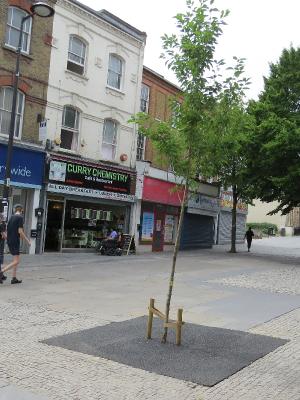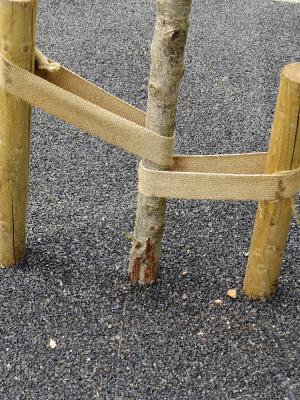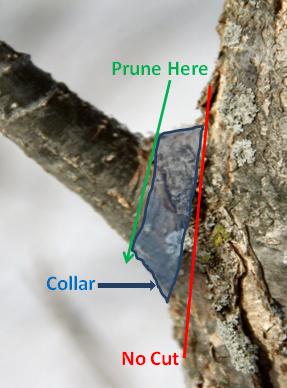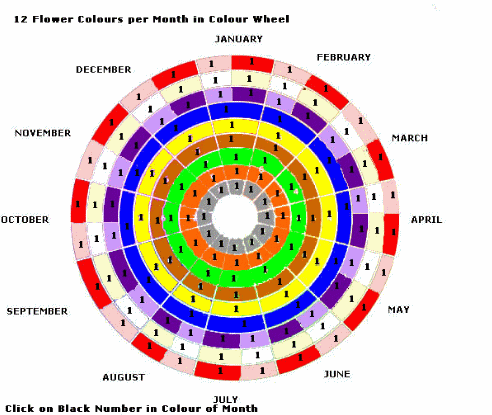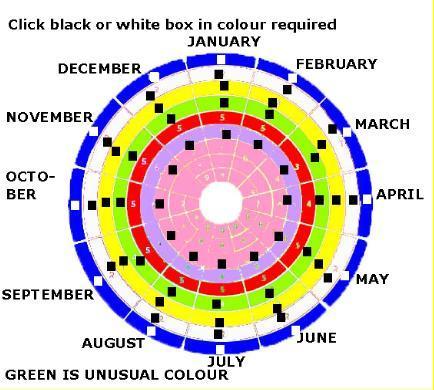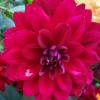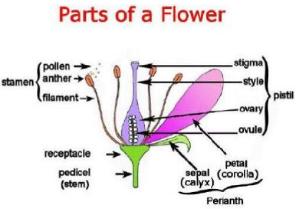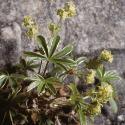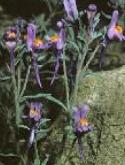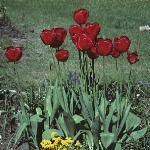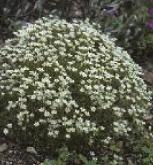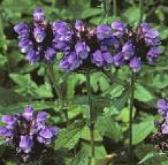Ivydene Gardens Extra Pages of Plants |
"Grow Grafting Service – A specialist service unique to Brogdale. Brogdale is the home of the national fruit collection and Grow is the on site specialist nursery and garden centre that for many years have accessed the collection to produce heritage apples and pears from the thousands of varieties on offer. For a lot of customers the desire to own a heritage variety stems from tasting the fruit at one of our festivals or a resonant memory from there past. People recognise that within the spectrum of fruit flavours we are exposed to just a small portion when purchasing fruit from commercial sources like supermarkets. Another reason to access this process is create area specific orchards, most counties and countries have locally bred fruits and it is wonderful to re-establish this link. Also we provide a service to graft from a tree you want to preserve, last year (2012) nearly 600 trees were ‘duplicated’ for a variety of customers. Sometimes the trees were of an unknown variety but obviously had personal significance; an added advantage was to start afresh as a young tree with a modern rootstock." from Grow at Brogdale. |
||||
Choosing a top fruit tree instead of a tree from the tree list provides you with a plant of a size that is suitable for most current gardens. These trees also produce edible fruit. |
|||||
|
The size of the tree required |
This is controlled by the fruit tree rootstock chosen. Apples from Very Dwarfing on M27 at 5-6 feet ultimate height to Very Vigorous on M25 with 25-30 feet ultimate height. Ultimate heights for other fruit trees given in their header row. |
|||
|
Varieties for ease of management |
Choose varieties with good disease resistance |
|||
|
Earlies, mids, lates. |
Choose varieties that can be eaten from August, or store well until Spring. |
|||
|
Triploids |
Triploids will require 2 other pollinators. |
|||
|
Dwarfing trees |
These need the best soil and a permanent stake. |
|||
|
Trained top fruit trees |
If space is limited and a 'sunny' wall or fence is available, 'trained' forms of top fruit tree such as cordons, espaliers and fans are ideal. |
|||
|
Best time to plant |
The best time to plant is during the dormant season from mid-November to mid-March. Bare rooted plants have to be planted at this time, with no competition from other plants for 2 feet radius from their trunk - I was asked in August 2017 to look at some plum trees grown on a slope within a lawn after 2 days of heavy rain. One had dead branches and the others dehydrated fruit. With the owner's permission, I (as a retired garden designer, garden constructor and maintenance man during 21 years before I retired due to heart failure and various other medical complaints) dug into the lawn with a trowel and pulled the turf back to show that the ground underneath was bone dry. I suggested that the turf be removed using a fork to reduce damage to the tree roots; to 36 inch (90 cms) radius from each trunk, then when the grass was cut to apply it as a mulch in the exposed soil, and perhaps grow only bulbs in that mulched soil. Having rested from my no-charge-labour of pulling up a 3 inch (7.5 cms) width of turf, I then pushed it back into its place, before wearily dragging my carcase off the premises. One large tree can lift up to 100 gallons of water out of the ground and discharge it into the air in a day. Tree roots do not grow very deep. Most tree roots are in the top 12 inches of soil. Tree roots often extend two to three times the width of the tree canopy.
|
|||
|
Site |
The ideal site would be a well sheltered South facing slope. More vigorous rootsocks have more root to provide better anchorage on exposed sites. All fruit trees need good light to produce good quality fruit, and a site facing South or West is best. However, Pears and Apples will fruit when facing East. Morello Cherries and Cooking Apples will all produce some fruit on a site facing North. |
|||
Soil "Grow Your Own Fruit" by Ken Muir, Honeypot Farm, Weeley Heath, Clacton-On-Sea, Essex. CO16 9BJ Tel: 01255 830181 provides the information on cultural practices in a clear and concise manner, as does "The RHS Encyclopedia of Practical Gardening FRUIT" by Harry Baker ISBN 1 85732 905 8. Pollination
Top Fruit Tree Form. Tree Form refers to the way in which the tree has been trained:-
Keepers Nursery of Gallants Court, East Farleigh, Maidstone, Kent ME15 0LE (Tel: 01622 726465 Fax: 0870 705 2145) produce over 600 varieties of fruit trees. Their website www.keepers-nursery.co.uk can provide further details including colour photographs of most of the following trees in this page. The following bare-root trees from 'Grow' at Brogdale Farm, Brogdale Road, Faversham, Kent. ME13 8XZ (Tel: 01795 531 888) would be supplied between November and April, which is their time for lifting and planting bare-root trees, through Brogdale Horticultural Trust at www.brogdale.org. One of the largest collections of apples in the world! |
|||||
Apple Rootstock Ultimate Height |
M27 5-6 feet |
M9 8-10 feet |
M26 10-15 feet |
MM106 14-18 feet |
M25 25-30 feet |
Uses |
Vertical cordons, |
Oblique cordon, |
Oblique cordon, |
Double Cordon., |
Standards |
Fruiting in |
2-3 years |
3-4 years |
3-4 years |
4-5 years |
6-7 years |
Full cropping |
4-5 years |
5-6 years |
5-6 years |
7-8 years |
8-9 years |
Planting Distance |
5-6 feet |
8-10 feet |
10-12 feet |
14-18 feet |
30 feet |
Soil/Site |
Requires a good deep fertile loam, clean ground, Not for heavy (Clay) soils |
Requires a good deep fertile loam, clean ground, no competition from other plants. Not for heavy (Clay) soils |
Requires a good deep fertile loam. Not for heavy (Clay) soils |
Can tolerate heavier soils and more exposed sites. |
Will tolerate most sites and soils. Good pest and disease resistance. Not the tree to plant if space is limited. |
Stake |
Permanent stake |
Permanent stake |
for 5 years |
for 5 years |
for 5 years |
Apple Name |
Cooker/Dessert |
Pollination Group Number |
Tree Form Availability |
Pick month/ |
Description |
Adams Pearmain |
Dessert |
2 |
M9- Maiden, M25-Standard |
Pick Early October/ Keep Nov-March |
Red-Brown, with a rich aromatic, nutty flavour. Excellent keeper. Attractive blossom. |
Annie Elizabeth |
Cooker |
4 |
MM106-Maiden |
Pick October/ Keep February |
Orange with a red flush. Large fruit with a sweet flavour. A good keeper and ideal for stewing. Remains popular with northern gardeners. Keeps shape when cooked. |
Ashmeads Kernel |
Dessert |
5 |
M9-Maiden |
Pick October/ Keep February |
Connoisseur's choice. Attractive red flowers and green or yellow flushed fruit with a taste of Fruit Drops.Good cropping but erratic due possibly to cold Spring. |
Bardsey |
Dessert |
3 |
M25-Standard |
Pick October/ Keep January |
The 'sainted' apple found growing on Bardsey Island in Wales in 1998. This pink over cream, lemon scented apple is unique and very disease resistant. |
Beauty of Bath |
Dessert |
2 |
MM106-Maiden |
Pick August/ Do not Keep |
Bright red flush on yellow, pink stained flesh. Sweet and juicy when ripe. Overripe it will taste fermented. Can 'drop' before being ripe. |
Blenheim Orange |
Dessert/Cooker |
3 Triploid |
MM106-Maiden |
Pick October/ Keep January |
Orange-red apple. Sweet nutty flavour. Good with cheese and for Apple Charlotte. Biennial in heavy fruit production. |
Bountiful |
Cooker |
2 |
MM106-Maiden |
Pick September/ Keep November |
An apple that keeps its shape when cooked. Soft, juicy and sweet.Resistant to mildew. |
Braeburn |
Dessert |
4 |
MM106 |
Pick October/ Keep March |
Crisp, firm, aromatic fruit. Excellent all round quality, requires a sheltered sunny spot. |
Bramley |
Cooker |
3 Triploid |
M27-Bush |
Pick October/ Keep March |
The most popular cooker. Greenish-yellow with a strong acid flavour. Vigorous growth. First trees planted commercially in Kent in 1890. |
Charles Ross |
Dessert/Cooker |
3 |
M27-Maiden |
Pick September/ Keep December |
Easy to grow eating apple. Best used early for cooking. Sweet flavoured with an orange red flush. Good chalk tolerance and scab resistance. A valued garden apple. |
Claygate Pearmain |
Dessert |
2 |
MM106-Maiden |
Pick October/ Keep February |
Rich and aromatic with a nutty taste. Combines the qualities of Blenheim and Ribston. Flushed orange-red over greenish-yellow background. Good cropping. |
Court Pendu Plat |
Dessert |
5 |
M9-Maiden |
Pick October/ Keep March |
Greenish-yellow flushed orange/red. Rich and fruity pineapple flavour. Good frost resistance and keeps flavour when stored. Among top ten Victorian dessert apples. |
Cox |
Dessert |
3 |
M26-Maiden |
Pick October/ Keep January |
A very self-fertile form. For less than ideal Cox growing conditions. Spicy, honeyed, nutty, pear-like aromatic flavour. |
Cornish Aromatic |
Dessert |
4 |
M25-Maiden |
Pick October/ Keep January |
Bright Red with russeting. Sweet, sharp pear drop and spice flavour. Light crop. |
D'arcy Spice |
Dessert |
3 |
M25-Standard |
Pick October/ Keep |
Bright green becoming gold with red flush. Hot, spicy nutmeg flavour. Erratic cropping. |
Devonshire Quarrenden |
Dessert |
2 |
MM106-Bush |
Pick August/ Keep September |
Dark, bright red-crimson fruit with distinct strawberry/wine flavour. Soon goes soft once picked. |
Discovery |
Dessert |
3 |
M26-Maiden |
Pick August/ Does not Keep |
Bright red flush. Crisp and juicy with a hint of strawberry. Disease resistant. Slow to bear. |
Egremont Russet |
Dessert |
2 |
M9-Maiden |
Pick October/ Keep December |
The most popular Russet, with cream-tinged-yellow firm flesh and a sweet and nutty flavour. Makes an upright tree with very good frost and disease resistance, so suitable for organic growing. A good pollinator. |
Ellison's Orange |
Dessert |
4 |
M26-Maiden |
Pick September/ Keep October |
Striped red juicy apple. Intense flavour turning to aniseed when ripe. Good scab and frost resistance. Good crop. |
Fiesta |
Dessert |
3 |
M27-Maiden |
Pick October/ Keep January |
Rich aromatic and sweet 'Cox' like flavour. Heavy crops, good frost resistance makes this an ideal variety for Northern areas. Grown commercially in Kent. |
Gala |
Dessert |
4 |
M26-Maiden |
Pick October/ Keep January |
A reliable cropper with good crisp, refreshing well flavoured fruit. Prone to canker and scab. |
George Cave |
Dessert |
2 |
MM106-Bush |
Pick August/ Does not Keep |
White flesh with a strong, sweet-sharp taste. |
Golden Noble |
Cooker |
4 |
MM106-Maiden |
Pick October/ Keep March |
One of the best cookers. Sharp and well flavoured but needing little sugar. Ideal for pies. Keeps well. A tip-bearing variety. Resistant to scab and mildew. |
Golden Pippin |
Dessert Cooker |
2 |
M25-Standard |
Pick October/ Keep January |
Gold with russet dots. A sweet flavour with a lemon tang. Cooks well. |
Great Expectations |
Dessert |
5 |
MM106-Bush |
Pick October/ Keep November |
Small and russeted with a superb flavour and very attractive blossom. Spreading tree. |
Greensleaves |
Dessert |
3 |
M26-Bush |
Pick September/ Does not Keep |
Excellent garden tree and apple. Pale, greenish-yellow, with a crisp, tangy flavour. Very easy to grow. Eat from the tree. Heavy cropper |
Grenadier |
Cooker |
3 |
M26-Bush |
Pick September/ Does not Keep |
A heavy cropping cooking apple with greeny-yellow fruit. Cooks to a creamy, sharp puree. |
Herefordshire Russet |
Dessert |
3 |
MM106-Maiden |
Pick September/ Keep January |
An excellent new variety (2004) of russet with a rich and aromatic Cox-like flavour. Stores well. |
Howgate Wonder |
Cooker |
3 |
MM106-Bush |
Pick October/ Keep March |
Large yellow red-striped cooker, with a light flavour. Keeps shape well when cooked. Spreading tree. Resistant to mildew. |
James Grieve |
Dessert/ Cooker |
3 |
MM106-Maiden |
Pick September/ Keep October |
Red-flushed-stripes over pale green. Crisp and juicy with good flavour. Can be picked early and used as a cooker. A reliable cropper. Resistant to mildew. Spreading tree. |
Jupiter |
Dessert |
3 |
M26-Bush |
Pick October/ Keep January |
Large and Cox-like with a more robust flavour. Sweet and juicy flesh. Biennial fruiting. |
Katy |
Dessert |
3 |
M26-Maiden |
Pick September/ Does not Keep |
Heavy crops of bright red early fruit with sweet strawberry flavoured firm flesh. A good pollinator. Once picked, soon goes soft. Syn Katja. |
Kidd's Orange Red |
Dessert |
3 |
M26-Maiden |
Pick October/ Keep January |
Yellow with red stripes. Sweet, crisp and aromatic. A good Cox alternative. Needs plenty of autumn sunshine to build up flavours. |
Laxton's Superb |
Dessert |
4 |
MM106-Maiden |
Pick October/ Keep November |
Will grow where Cox fails to thrive, and has some of its rich complexity of flavour. It is sweet with a fine textured quite juicy flesh. Spreading tree instead of normal upright apple tree growth. |
Limelight |
Dessert |
4 |
M9-Maiden |
Pick September/ Keep November |
Excellent garden variety; a crisp and refreshing green apple with a good disease resistance. |
Lord Derby |
Cooker |
3 |
M26-Maiden |
Pick October/ Keep December |
A good strong tasting cooking apple for pies beautiful flowers. Good for northern areas. Good cropping. |
Lord Lambourne |
Dessert |
2 |
MM106-Maiden |
Pick September/ Keep November |
Bright striped fruit, moderatley sweet and aromatic with some strawberry flavour. A good garden apple. Tip-bearing. Resistant to mildew. |
Mabbot's Pearmain |
Dessert |
3 |
MM106-Bush |
Pick September/ Keep December |
Thickly speckled russetted apple over an orange-red flush. A sharp refeshing taste of fruit. Heavy cropping. |
Meridian |
Dessert |
3 |
M26-Maiden |
Pick September/ Keep March |
A large Red Falstaff x Cox cross, with a juicy aromatic flavour. A heavy cropping disease-resistant variety, which also has good keeping qualities. |
Orange Gofff |
Cooker |
2 |
MM106-Bush |
Pick September/ Keep December |
Good for fruit jams and sauces, an orange fleshed dual purpose apple, which keeps its shape when cooked. Was used to 'help' marmalade producers in Dundee until practice stopped by Adulteration Act. |
Orleans Reinette |
Dessert |
4 |
M26-Bush |
Pick September/ Keep December |
Golden-yellow fruit flushed red, with nutty aromatic sweet firm flesh. Dual purpose. Makes sweet baked apple using early fruit. Needs warm spot for good flavour. |
Peasgood Nonesuch |
Cooker/Dessert |
3 |
MM106-Bush |
Pick September/ Keep December |
Pale green with broken red stripes and an orange flush. Good for baking and salads. Spreading tree. Resistant to mildew , red spider and partly to scab. |
Pitmaston Pine Apple |
Dessert |
3 |
MM106 |
Pick September/ Keep December |
A small conical apple with a distinctive taste of pineapple blended with honey and musk. Upright tree. Crops heavily and biennially. |
Queen Cox |
Dessert |
3 |
M9-Maiden |
Pick September/ Keep January |
Cox's Orange (Queen) is a more highly coloured variety of Cox's Orange Pippin. An intense aromatic flavour. |
Red Devil |
Dessert |
3 |
M27-Maiden |
Pick September/ Keep December |
Good garden variety with scarlet flush. Good fruity strawberry flavour. Disease resistant. Raised in Faversham, Kent. Heavy cropper. |
Falstaff (Red) |
Dessert |
3 |
M27-Maiden |
Pick October/ Keep March |
Fruity, well-balanced flavour. Crisp and juicy. One of the heaviest yielding apples. Can be stored easily and eaten throughout the winter. Frost resistant. Planted commercially in kent. |
Red Millers Seedling |
Dessert |
2 |
MM106-Bush |
Pick August/ Does not Keep |
Medium pale yellow with bright red flush. Crisp, soft white sweet flesh. heavy cropping biennally. |
Red Windsor |
Dessert |
2 |
M27-Maiden |
Pick September/ Keep October |
Superb Cox-like flavour. A good cropping garden variety. |
Reinne de Reinettes |
Cooker |
3 |
M25-Maiden |
Pick Early October/ Keep December |
Sweet with plenty of acidity. Keeps shape when cooked. Ideal for 'Tarte Tartin'. Syn. King of the Pippins. Upright tree with good disease resistance. |
Ribston Pippin |
Dessert |
2 |
MM106-Maiden |
Pick October/ Keep January |
Yellow, flushed brown/orange fruit. Intense rich aromatic flavour. Juicy and firm. Sharper than Cox. Upright tree. Resistant to scab. |
Rosemary Russet |
Dessert |
3 |
M25-Maiden |
Pick October/ Keep March |
Pale Yellow flushed bright reddish-brown. Intensely flavoured of Acid Drops. Upright tree. Good cropper. |
Saturn |
Dessert |
3 |
M27-Maiden |
Pick September Keep February |
Very resistant to scab. Heavy crops of attractive red blushed conical fruit. Firm flesh and sweet flavour. |
Scrumptious |
Dessert |
3 |
M27-Maiden |
Pick Mid September/ Does not Keep |
Frost and disease resistant, fragrant and honey. Eat straight from tree. Doesn't drop. |
Spartan |
Dessert |
3 |
M26-Bush |
Pick October/ Keep January |
Popular eater. Fruit dark red, sweet, crisp and juicy. Easy to grow. |
Sunset |
Dessert |
3 |
M27-Maiden |
Pick September/ Keep December |
Similar to Cox, but more disease resistant. Sharp intense flavour. Heavy cropper. Excellent garden apple. |
Sweet Society |
Dessert |
4 |
M26-Maiden |
Pick September/ Keep January |
Selected by the Royal Horticultural Society to celebate their bi-centennial. An attractive slightly small Cox type apple with superb aromatic eating qualities. |
Tydeman's Late Orange |
Dessert |
3 |
MM106-Maiden |
Pick October/ Keep October |
Orange/Red colour with some russeting. Firm and sweet. Rich and aromatic. Trouble free. Heavy cropping. If fruit is not thinned, then the fruit will be small. |
Winter Gem |
Dessert |
3 |
M27-Bush |
Pick October/ Keep February |
Heavy cropping. Handsome orange/red flushed over gold. Tasty, rich and aromatic. |
Worcester Pearmain |
Dessert |
3 |
M27-Maiden |
Pick September/ Keep October |
Reliable heavy crop of delicious orange-red fruit. Firm and juicy flesh. Very sweet flavour with a hint of strawberry. Distinctive blossom- almond opening to silvery white. |
Yellow Ingestrie |
Dessert |
1 |
M25-Maiden |
Pick September/ Keep October |
Greenish-yellow fruit turning yellow. Sharp, fruity and firm. Spreading tree. Good cropping. Ideal for wiring onto evergreens to make Kissing Boughs and sprays. |
|
|||||
Cider apples are grown as standard trees to produce the maximum yield for juice production. Brogdale Horticultural Trust has an Apple National Collection of 2111 varieties and has a Cider Apple Weekend Event each September and Cider Fest Evening Event each October. |
|||||
Cider Apple Name |
Pollination Group Number |
Tree Form Availability |
Pick month |
Description |
|
Dabinett |
5 |
M25-Maiden |
Pick November |
The most reliable cider variety producing high quality juice. Produces bittersweet cider with 'soft, full bodied, astringency'. |
|
Herefordshire Redstreak |
5 |
M25-Maiden |
Pick November |
A very famous cider apple. Flesh is a vibrant red streak colour as the name suggests. |
|
Harry Masters Jersey |
5 |
M25-Maiden |
Pick October |
Known as port wine. A full bittersweet cider taste with soft astringency. |
|
Tom Putt |
3 |
M25-Maiden |
Pick September |
Bright red with streaks. Firm, crisp and sharp. Sweet when cooked. Scab resistant. Widely planted in West Midlands in 1920s. |
|
|
|||||
Pears flower early and so are liable to damage by spring frosts and cold winds. It is best to grow them as Minarettes, Cordons and Espaliers on warm South, South-West or West facing walls or fences. Brogdale Horticultural Trust has a Pear National Collection of 522 varieties. Self-guided walks with a Plant Centre and Tea rooms are available every day. |
|||||
Pear and Quince Rootstock |
Quince 'C' (QC) |
Quince 'A' (QA) |
PYC |
||
Ultimate height for a Bush tree |
6-10 feet |
8-10 feet |
30 feet |
||
Half Standard |
N/A |
Maximum 16 feet |
25-30 feet |
||
Uses |
Cordon |
Fan |
Standard Tree |
||
Fruiting |
4 years |
4 years |
6-7 years |
||
Full cropping |
6-7 years |
7 years |
8-9 years |
||
Planting Distance |
6-10 feet |
10-15 feet |
30 feet |
||
Staking |
Permanently |
5 years |
5 years |
||
Soil |
Fertile soil which does not dry out too quickly |
Most fertile medium to heavy soils |
Less than ideal soil conditions. |
||
Pear Name |
Pollination Group Number |
Tree Form Availability Rootstock. Ultimate Height |
Pick month/ |
Description |
|
Beth |
3 |
QA-Bush |
Pick September/ Does not Keep |
Pale green turning pale yellow. Small and sweet. Good for gardens. |
|
Beurre Hardy |
4 |
QC-Bush |
Pick September/ Keep October |
Medium large and light green. Tender and juicy, rose-water flavour. |
|
Concorde |
4 |
QC-Maiden |
Pick September/ Keep November |
Medium to large fruit. Pale green turning yellow. Sweet and juicy flesh with a pleasant mild flavour. |
|
Conference |
3 |
QA-Maiden |
Pick September/ Keep November |
Medium yellow-green. Sweet, juicy, good cropper. |
|
Doyenne du Comice |
4 |
QA-Bush |
Pick October/ Keep December |
Large, pale green fruit. Rich, juicy superb flavour. Needs good pollinator such as Concorde. |
|
Durondeau |
3 |
PYC-Maiden |
Pick September/ Keep November |
Attractive medium fruit with a juicy sweet flavoured flesh. Needs a moist soil . The flowers resist frost well making it good for the north. |
|
Emile D'Heyst |
2 |
QA-Maiden |
Pick September/ Keep November |
One of the most reliable croppers even in the north. Light green medium sized fruit with a firm yellowish green flesh. Sweet, juicy and sub-acid flavour. |
|
Jargonelle |
1 |
PYC-Maiden |
Pick August/ Does not Keep |
Suitable for growing anywhere North or South in the United Kingdom. Good frost and disease resistance. The yellow flesh is tender and juicy. Tip bearer. |
|
Louise Bonne of Jersey |
2 |
QA-Maiden |
Pick September/ Keep October |
Small/medium in size. Pale yellowish-green fruit with a dark red flush. Melting sweet white flesh. Reliable cropper. |
|
Packham's Triumph |
3 |
QA-Bush |
Pick October/ Keep December |
Medium to large bright fruit if thinned. Compact growing tree. |
|
Williams |
3 |
QC-Bush |
Pick August/ Does not Keep |
Medium size fruit. Sweet and juicy. Regular cropping but does not keep. |
|
|
|||||
Sweet Cherries crop best under conditions of light rainfall, 2 feet deep of fertile, well-drained soil. They flower early and so require protection against spring frosts. Best grown as a Dwarf Bush tree. Brogdale Horticultural Trust has a Cherry National Collection of 320 varieties and has a Cherry Blossom Week Event each April and Cherry Week Event each July. |
|||||
Sweet Cherry Rootstock |
G5 |
Colt |
|||
Ultimate Height |
10 feet |
20 feet |
|||
Uses |
Dwarf Bush Tree |
Bush |
|||
Fruiting |
3 years |
3-4 years |
|||
Full cropping |
3 years |
5 years |
|||
Staking |
Permanently |
5 years |
|||
Soil |
Requires good, fertile, deep loam |
Tolerant of lighter, chalky or heavier clay soils |
|||
Sweet Cherry Name |
Pollinator |
Tree Form Availability Rootstock. Height |
Pick month |
Description |
|
Celeste |
Self-fertile |
Colt-Bush |
|
Sweet cherry. Dark red fruits of excellent eating quality. A naturally compact growth habit. |
|
Lapins |
Self-fertile |
G5-Maiden |
Pick Late July |
Sweet cherry. Large dark red fruit. A good garden tree with an upright habit. |
|
Merton Glory |
Pollinated by either Stella or Sunburst |
G5-Maiden |
Pick Early July |
Sweet cherry. Very large heart-shaped, white with pink flush. A sweet fruit making a shapely compact tree. |
|
Morello |
Self-fertile |
G5-Maiden |
Pick July |
Acid cherry. Large dark red cooking cherry. Acid flavour. Very hardy and good for north walls. |
|
Penny |
Pollinated by Stella, Sunburst or Merton Glory |
G5-Maiden |
Pick Mid-Late August |
Sweet cherry. A new dark cherry from East Malling. Quite large, firm and a reliable cropper when young. |
|
Stella |
Self-fertile |
G5-Maiden |
Pick Late July |
Sweet cherry. Dark sweet and juicy fruit. Reliable cropper. |
|
Summer Sun |
Pollinated by Stella and Summer Sun |
G5-Maiden |
|
Sweet cherry. A sweet red cherry with a compact growth habit. Suitable for cold exposed areas. |
|
Sunburst |
Self-fertile |
G5-Maiden |
Pick Mid-July |
Sweet cherry. Georgeous flavour. |
|
Sweetheart |
Self-fertile |
G5-Maiden |
Pick Early August |
Sweet cherry. Firm red cherries with a good flavour. Fruits when young. |
|
Sylvia |
Pollinated by Celeste |
Colt-Maiden |
Pick Early August |
Sweet cherry. Large dark red fruit. A compact variety with attractive leaves. |
|
Height in inches (cms):- 25.4mm = 1 inch I normally round this to |
Site design and content copyright ©December 2006. Page structure changed September 2012. Height x Spread in feet changed to Height x Spread in inches (cms) May 2015. Data added to existing pages December 2017. Chris Garnons-Williams. DISCLAIMER: Links to external sites are provided as a courtesy to visitors. Ivydene Horticultural Services are not responsible for the content and/or quality of external web sites linked from this site. |
||||
|
|||||
This table has been copied from |
|||||||||||||||||||||||||||||||||||||||||||||||||||||||||||||||||||||||||||||||||||||||||||||||||||||||||||||||||||||||||||||||||||||||||||||||||||||||||||||||||||||||||||||||||||||||||||||||||||||||||||||||||||||||||||||||||||||||||||||||||||||||||||||||||||||||||||||||||||||||||||||||||||||||||||||||||||||||||||||||||||||||||||||||||||||||||||||||||||||||||||||||||||||||||||||||||||||||||||||||||||||||||||||||||||||||||||||||||||||||||||||||||||||||||||||||||||||||||||||||||||||||||||||||||||||||||||||||||||||||||||||||||||||||||||||||||||||||||||||||||||||||||||||||||||||||||||||||||||||||||||||||||||||||||||||||||||||||||||||||||||||||||||||||||||||||||||||||||||||||||||||||||||||||||||||||||||||||||||||||||||||||||||||||||||||||||||||||||||||||||||||||||||||||||||||||||||||||||||||||||||||||||||||||||||||||||||||||||||||||||||||||||||||||||||||||||||||||||||||||||||||||||||||||||||||||||||||||||||||||||||||||||||||||||||||||||||||||||||||||||||||||||||||||||
Pruning of
Some old or overgrown shrubs - such as those that produce new shoots from the base or from old wood - may be rejuvenated by hard pruning. Renovate deciduous shrubs after flowering or when dormant in January, and evergreen shrubs in mid-Spring. Cut back up to one-third of the oldest stems close to the base. Of those that remain, cut out the weak or dead wood, then rubbing, crossing or congested stems and finally shorten the oldest by half to strong buds. Repeat the following year, cutting back the remaining old main stems. For pruning of plants after their first year from planting in your garden; begin by removing dead, damaged or diseased wood, and then crossing shoots. If the 'normal' branch is horizontal, then cut out the vertical crossing branch. If the 'normal branch is vertical, then cut out the horizontal crossing branch. Remember to see whether the crossing branch you take out will affect the overall shape of the plant less than the other one - to make sure that you do not destroy the 'normal' shape of the plant. Then follow the respective pruning action for the Pruning Group for that plant in the following table:- |
|||||||||||||||||||||||||||||||||||||||||||||||||||||||||||||||||||||||||||||||||||||||||||||||||||||||||||||||||||||||||||||||||||||||||||||||||||||||||||||||||||||||||||||||||||||||||||||||||||||||||||||||||||||||||||||||||||||||||||||||||||||||||||||||||||||||||||||||||||||||||||||||||||||||||||||||||||||||||||||||||||||||||||||||||||||||||||||||||||||||||||||||||||||||||||||||||||||||||||||||||||||||||||||||||||||||||||||||||||||||||||||||||||||||||||||||||||||||||||||||||||||||||||||||||||||||||||||||||||||||||||||||||||||||||||||||||||||||||||||||||||||||||||||||||||||||||||||||||||||||||||||||||||||||||||||||||||||||||||||||||||||||||||||||||||||||||||||||||||||||||||||||||||||||||||||||||||||||||||||||||||||||||||||||||||||||||||||||||||||||||||||||||||||||||||||||||||||||||||||||||||||||||||||||||||||||||||||||||||||||||||||||||||||||||||||||||||||||||||||||||||||||||||||||||||||||||||||||||||||||||||||||||||||||||||||||||||||||||||||||||||||||||||||||||
Pruning Group Number |
Type of Plant |
Pruning Action |
When |
||||||||||||||||||||||||||||||||||||||||||||||||||||||||||||||||||||||||||||||||||||||||||||||||||||||||||||||||||||||||||||||||||||||||||||||||||||||||||||||||||||||||||||||||||||||||||||||||||||||||||||||||||||||||||||||||||||||||||||||||||||||||||||||||||||||||||||||||||||||||||||||||||||||||||||||||||||||||||||||||||||||||||||||||||||||||||||||||||||||||||||||||||||||||||||||||||||||||||||||||||||||||||||||||||||||||||||||||||||||||||||||||||||||||||||||||||||||||||||||||||||||||||||||||||||||||||||||||||||||||||||||||||||||||||||||||||||||||||||||||||||||||||||||||||||||||||||||||||||||||||||||||||||||||||||||||||||||||||||||||||||||||||||||||||||||||||||||||||||||||||||||||||||||||||||||||||||||||||||||||||||||||||||||||||||||||||||||||||||||||||||||||||||||||||||||||||||||||||||||||||||||||||||||||||||||||||||||||||||||||||||||||||||||||||||||||||||||||||||||||||||||||||||||||||||||||||||||||||||||||||||||||||||||||||||||||||||||||||||||||||||||||||||||
1. e.g. Acer palmatum |
Evergreen and deciduous trees/shrubs that flower on previous or current year's growth and need minimal pruning |
Remove crossing shoots to maintain framework. |
In late winter or early Spring, when dormant; some in late summer or early autumn to prevent sap bleeding. |
||||||||||||||||||||||||||||||||||||||||||||||||||||||||||||||||||||||||||||||||||||||||||||||||||||||||||||||||||||||||||||||||||||||||||||||||||||||||||||||||||||||||||||||||||||||||||||||||||||||||||||||||||||||||||||||||||||||||||||||||||||||||||||||||||||||||||||||||||||||||||||||||||||||||||||||||||||||||||||||||||||||||||||||||||||||||||||||||||||||||||||||||||||||||||||||||||||||||||||||||||||||||||||||||||||||||||||||||||||||||||||||||||||||||||||||||||||||||||||||||||||||||||||||||||||||||||||||||||||||||||||||||||||||||||||||||||||||||||||||||||||||||||||||||||||||||||||||||||||||||||||||||||||||||||||||||||||||||||||||||||||||||||||||||||||||||||||||||||||||||||||||||||||||||||||||||||||||||||||||||||||||||||||||||||||||||||||||||||||||||||||||||||||||||||||||||||||||||||||||||||||||||||||||||||||||||||||||||||||||||||||||||||||||||||||||||||||||||||||||||||||||||||||||||||||||||||||||||||||||||||||||||||||||||||||||||||||||||||||||||||||||||||||||
2. e.g. Forsythia |
Deciduous Shrubs that flower in Spring or early Summer on previous year's growth |
Cut back flowered shoots to strong buds or young lower or basal growth. On established plants, cut back about 1/4 of old shoots to the base, to promote replacement growth. |
Annually, after flowering. |
||||||||||||||||||||||||||||||||||||||||||||||||||||||||||||||||||||||||||||||||||||||||||||||||||||||||||||||||||||||||||||||||||||||||||||||||||||||||||||||||||||||||||||||||||||||||||||||||||||||||||||||||||||||||||||||||||||||||||||||||||||||||||||||||||||||||||||||||||||||||||||||||||||||||||||||||||||||||||||||||||||||||||||||||||||||||||||||||||||||||||||||||||||||||||||||||||||||||||||||||||||||||||||||||||||||||||||||||||||||||||||||||||||||||||||||||||||||||||||||||||||||||||||||||||||||||||||||||||||||||||||||||||||||||||||||||||||||||||||||||||||||||||||||||||||||||||||||||||||||||||||||||||||||||||||||||||||||||||||||||||||||||||||||||||||||||||||||||||||||||||||||||||||||||||||||||||||||||||||||||||||||||||||||||||||||||||||||||||||||||||||||||||||||||||||||||||||||||||||||||||||||||||||||||||||||||||||||||||||||||||||||||||||||||||||||||||||||||||||||||||||||||||||||||||||||||||||||||||||||||||||||||||||||||||||||||||||||||||||||||||||||||||||||
3. e.g. Kerria |
Deciduous shrubs that flower in Spring or early Summer on previous year's growth, and produce new growth at or near ground level. |
Cut back flowered shoots to young sideshoots or to strong buds low down on branch framework, to encourage new growth. |
Annually, after flowering |
||||||||||||||||||||||||||||||||||||||||||||||||||||||||||||||||||||||||||||||||||||||||||||||||||||||||||||||||||||||||||||||||||||||||||||||||||||||||||||||||||||||||||||||||||||||||||||||||||||||||||||||||||||||||||||||||||||||||||||||||||||||||||||||||||||||||||||||||||||||||||||||||||||||||||||||||||||||||||||||||||||||||||||||||||||||||||||||||||||||||||||||||||||||||||||||||||||||||||||||||||||||||||||||||||||||||||||||||||||||||||||||||||||||||||||||||||||||||||||||||||||||||||||||||||||||||||||||||||||||||||||||||||||||||||||||||||||||||||||||||||||||||||||||||||||||||||||||||||||||||||||||||||||||||||||||||||||||||||||||||||||||||||||||||||||||||||||||||||||||||||||||||||||||||||||||||||||||||||||||||||||||||||||||||||||||||||||||||||||||||||||||||||||||||||||||||||||||||||||||||||||||||||||||||||||||||||||||||||||||||||||||||||||||||||||||||||||||||||||||||||||||||||||||||||||||||||||||||||||||||||||||||||||||||||||||||||||||||||||||||||||||||||||||
4. e.g. Hydrangea macrophylla |
Deciduous shrubs that flower in mid to late Summer or Autumn on previous year's growth. |
Trim off last season's flowerheads to the first bud beneath each flowerhead. With established plants, cut back about 1/4 of old shoots to the base, to promote replacement growth. |
Annually, from early to mid-Spring. |
||||||||||||||||||||||||||||||||||||||||||||||||||||||||||||||||||||||||||||||||||||||||||||||||||||||||||||||||||||||||||||||||||||||||||||||||||||||||||||||||||||||||||||||||||||||||||||||||||||||||||||||||||||||||||||||||||||||||||||||||||||||||||||||||||||||||||||||||||||||||||||||||||||||||||||||||||||||||||||||||||||||||||||||||||||||||||||||||||||||||||||||||||||||||||||||||||||||||||||||||||||||||||||||||||||||||||||||||||||||||||||||||||||||||||||||||||||||||||||||||||||||||||||||||||||||||||||||||||||||||||||||||||||||||||||||||||||||||||||||||||||||||||||||||||||||||||||||||||||||||||||||||||||||||||||||||||||||||||||||||||||||||||||||||||||||||||||||||||||||||||||||||||||||||||||||||||||||||||||||||||||||||||||||||||||||||||||||||||||||||||||||||||||||||||||||||||||||||||||||||||||||||||||||||||||||||||||||||||||||||||||||||||||||||||||||||||||||||||||||||||||||||||||||||||||||||||||||||||||||||||||||||||||||||||||||||||||||||||||||||||||||||||||||
5. e.g. Prunus triloba |
Deciduous shrubs that flower between late Winter and early Spring on previous year's growth. |
Cut back all stems to strong buds or to developing shoots close to the base of the plant, to promote replacement growth. |
Annually, after flowering |
||||||||||||||||||||||||||||||||||||||||||||||||||||||||||||||||||||||||||||||||||||||||||||||||||||||||||||||||||||||||||||||||||||||||||||||||||||||||||||||||||||||||||||||||||||||||||||||||||||||||||||||||||||||||||||||||||||||||||||||||||||||||||||||||||||||||||||||||||||||||||||||||||||||||||||||||||||||||||||||||||||||||||||||||||||||||||||||||||||||||||||||||||||||||||||||||||||||||||||||||||||||||||||||||||||||||||||||||||||||||||||||||||||||||||||||||||||||||||||||||||||||||||||||||||||||||||||||||||||||||||||||||||||||||||||||||||||||||||||||||||||||||||||||||||||||||||||||||||||||||||||||||||||||||||||||||||||||||||||||||||||||||||||||||||||||||||||||||||||||||||||||||||||||||||||||||||||||||||||||||||||||||||||||||||||||||||||||||||||||||||||||||||||||||||||||||||||||||||||||||||||||||||||||||||||||||||||||||||||||||||||||||||||||||||||||||||||||||||||||||||||||||||||||||||||||||||||||||||||||||||||||||||||||||||||||||||||||||||||||||||||||||||||||
6. e.g. Buddleja davidii |
Deciduous shrubs that flower in mid to late Summer or Autumn on current year's growth. |
Cut back to low permanent framework. For Sub-Shrubs, and for drastic renovation, cut back all flowered stems close to the base. |
Annually, as buds begin to swell in early spring. |
||||||||||||||||||||||||||||||||||||||||||||||||||||||||||||||||||||||||||||||||||||||||||||||||||||||||||||||||||||||||||||||||||||||||||||||||||||||||||||||||||||||||||||||||||||||||||||||||||||||||||||||||||||||||||||||||||||||||||||||||||||||||||||||||||||||||||||||||||||||||||||||||||||||||||||||||||||||||||||||||||||||||||||||||||||||||||||||||||||||||||||||||||||||||||||||||||||||||||||||||||||||||||||||||||||||||||||||||||||||||||||||||||||||||||||||||||||||||||||||||||||||||||||||||||||||||||||||||||||||||||||||||||||||||||||||||||||||||||||||||||||||||||||||||||||||||||||||||||||||||||||||||||||||||||||||||||||||||||||||||||||||||||||||||||||||||||||||||||||||||||||||||||||||||||||||||||||||||||||||||||||||||||||||||||||||||||||||||||||||||||||||||||||||||||||||||||||||||||||||||||||||||||||||||||||||||||||||||||||||||||||||||||||||||||||||||||||||||||||||||||||||||||||||||||||||||||||||||||||||||||||||||||||||||||||||||||||||||||||||||||||||||||||||
7. e.g. Cornus alba |
Deciduous trees and shrubs that, when pruned hard, produce colourful winter stems, or large or brightly hued foliage, as ornamental features. Plants that flower on previous year's wood do not bloom if pruned this way. |
Cut back all stems to within 2 or 3 buds of the base, or to the permanent framework. Feed or apply well-rotted farmyard manure, and mulch to compensate for loss of wood. |
Annually, in early Spring. |
||||||||||||||||||||||||||||||||||||||||||||||||||||||||||||||||||||||||||||||||||||||||||||||||||||||||||||||||||||||||||||||||||||||||||||||||||||||||||||||||||||||||||||||||||||||||||||||||||||||||||||||||||||||||||||||||||||||||||||||||||||||||||||||||||||||||||||||||||||||||||||||||||||||||||||||||||||||||||||||||||||||||||||||||||||||||||||||||||||||||||||||||||||||||||||||||||||||||||||||||||||||||||||||||||||||||||||||||||||||||||||||||||||||||||||||||||||||||||||||||||||||||||||||||||||||||||||||||||||||||||||||||||||||||||||||||||||||||||||||||||||||||||||||||||||||||||||||||||||||||||||||||||||||||||||||||||||||||||||||||||||||||||||||||||||||||||||||||||||||||||||||||||||||||||||||||||||||||||||||||||||||||||||||||||||||||||||||||||||||||||||||||||||||||||||||||||||||||||||||||||||||||||||||||||||||||||||||||||||||||||||||||||||||||||||||||||||||||||||||||||||||||||||||||||||||||||||||||||||||||||||||||||||||||||||||||||||||||||||||||||||||||||||||
8. e.g. Camellia, Rhododendron |
Evergreen shrubs that flower between Winter and early Summer on previous or current year's growth, and need minimal pruning. |
Trim or lightly cut back shoots that spoil symmetry. Dead-head regularly if practical (unless fruit is required). |
Annually, after flowering. Remove dead and damaged growth in mid-Spring. |
||||||||||||||||||||||||||||||||||||||||||||||||||||||||||||||||||||||||||||||||||||||||||||||||||||||||||||||||||||||||||||||||||||||||||||||||||||||||||||||||||||||||||||||||||||||||||||||||||||||||||||||||||||||||||||||||||||||||||||||||||||||||||||||||||||||||||||||||||||||||||||||||||||||||||||||||||||||||||||||||||||||||||||||||||||||||||||||||||||||||||||||||||||||||||||||||||||||||||||||||||||||||||||||||||||||||||||||||||||||||||||||||||||||||||||||||||||||||||||||||||||||||||||||||||||||||||||||||||||||||||||||||||||||||||||||||||||||||||||||||||||||||||||||||||||||||||||||||||||||||||||||||||||||||||||||||||||||||||||||||||||||||||||||||||||||||||||||||||||||||||||||||||||||||||||||||||||||||||||||||||||||||||||||||||||||||||||||||||||||||||||||||||||||||||||||||||||||||||||||||||||||||||||||||||||||||||||||||||||||||||||||||||||||||||||||||||||||||||||||||||||||||||||||||||||||||||||||||||||||||||||||||||||||||||||||||||||||||||||||||||||||||||||||
9. e.g. Eucryphia |
Evergreen shrubs that flower between mid-Summer and late Autumn on previous or current year's growth, or that bear insignificant flowers, and that need minimal pruning. |
Trim or lightly cut back shoots that spoil symmetry. Shrubs grown for foliage often tolerate harder pruning. Dead-head regularly if practical (unless fruit is required). |
Annually, or as necessary, from mid to late Spring. |
||||||||||||||||||||||||||||||||||||||||||||||||||||||||||||||||||||||||||||||||||||||||||||||||||||||||||||||||||||||||||||||||||||||||||||||||||||||||||||||||||||||||||||||||||||||||||||||||||||||||||||||||||||||||||||||||||||||||||||||||||||||||||||||||||||||||||||||||||||||||||||||||||||||||||||||||||||||||||||||||||||||||||||||||||||||||||||||||||||||||||||||||||||||||||||||||||||||||||||||||||||||||||||||||||||||||||||||||||||||||||||||||||||||||||||||||||||||||||||||||||||||||||||||||||||||||||||||||||||||||||||||||||||||||||||||||||||||||||||||||||||||||||||||||||||||||||||||||||||||||||||||||||||||||||||||||||||||||||||||||||||||||||||||||||||||||||||||||||||||||||||||||||||||||||||||||||||||||||||||||||||||||||||||||||||||||||||||||||||||||||||||||||||||||||||||||||||||||||||||||||||||||||||||||||||||||||||||||||||||||||||||||||||||||||||||||||||||||||||||||||||||||||||||||||||||||||||||||||||||||||||||||||||||||||||||||||||||||||||||||||||||||||||||
10. e.g. Calluna, Erica, Lavandula |
Evergreen shrubs that flower on previous year's growth in Spring or early Summer, or on current year's growth in late Summer or Autumn. (Tree heathers require only minimal pruning). |
Cut back flowered shoots to within 1" (2.5cm) of previous year's growth. |
Annually:
|
||||||||||||||||||||||||||||||||||||||||||||||||||||||||||||||||||||||||||||||||||||||||||||||||||||||||||||||||||||||||||||||||||||||||||||||||||||||||||||||||||||||||||||||||||||||||||||||||||||||||||||||||||||||||||||||||||||||||||||||||||||||||||||||||||||||||||||||||||||||||||||||||||||||||||||||||||||||||||||||||||||||||||||||||||||||||||||||||||||||||||||||||||||||||||||||||||||||||||||||||||||||||||||||||||||||||||||||||||||||||||||||||||||||||||||||||||||||||||||||||||||||||||||||||||||||||||||||||||||||||||||||||||||||||||||||||||||||||||||||||||||||||||||||||||||||||||||||||||||||||||||||||||||||||||||||||||||||||||||||||||||||||||||||||||||||||||||||||||||||||||||||||||||||||||||||||||||||||||||||||||||||||||||||||||||||||||||||||||||||||||||||||||||||||||||||||||||||||||||||||||||||||||||||||||||||||||||||||||||||||||||||||||||||||||||||||||||||||||||||||||||||||||||||||||||||||||||||||||||||||||||||||||||||||||||||||||||||||||||||||||||||||||||||
11. e.g. Akebia, Clematis montana |
Vigorous, deciduous and evergreen climbers that flower on previous or current year's growth, and need no regular pruning. |
Trim to fit available space; carry out renovation pruning as needed |
Annually, or as needed:
|
||||||||||||||||||||||||||||||||||||||||||||||||||||||||||||||||||||||||||||||||||||||||||||||||||||||||||||||||||||||||||||||||||||||||||||||||||||||||||||||||||||||||||||||||||||||||||||||||||||||||||||||||||||||||||||||||||||||||||||||||||||||||||||||||||||||||||||||||||||||||||||||||||||||||||||||||||||||||||||||||||||||||||||||||||||||||||||||||||||||||||||||||||||||||||||||||||||||||||||||||||||||||||||||||||||||||||||||||||||||||||||||||||||||||||||||||||||||||||||||||||||||||||||||||||||||||||||||||||||||||||||||||||||||||||||||||||||||||||||||||||||||||||||||||||||||||||||||||||||||||||||||||||||||||||||||||||||||||||||||||||||||||||||||||||||||||||||||||||||||||||||||||||||||||||||||||||||||||||||||||||||||||||||||||||||||||||||||||||||||||||||||||||||||||||||||||||||||||||||||||||||||||||||||||||||||||||||||||||||||||||||||||||||||||||||||||||||||||||||||||||||||||||||||||||||||||||||||||||||||||||||||||||||||||||||||||||||||||||||||||||||||||||||||
12. e.g. Solanum crispum |
Less vigourous, deciduous and evergreen climbers that flower on previous or current year's growth. |
"Spur prune" by cutting back side-shoots to within 4 buds of it's main stem. Thin out overcrowded shoots by unravelling every branch onto the ground. Then, retie the main branches to its support - this could be chainlink fencing from 24 to 60 inches (60-150 cms) with twine not with plastic, metal or rubber. Then starting at the base, inspect each sub-branch and tie it to the climber support. Then tie the next one if there is room; if not cut it back to within 4 buds of its connection to its parent branch. And carry on up that sub-branch, until all its sub-branches have been dealt with. Then repeat the process on the next main branch system, until all the branch structure has been retied. You will end up with a lot more flowers and a better looking climber. This complete process may well need to be done every 2 or 3 years, so that you do not end up with a thick mass of twigs and a leafy climber on the outside after 4 to 5 years. |
Annually:
|
||||||||||||||||||||||||||||||||||||||||||||||||||||||||||||||||||||||||||||||||||||||||||||||||||||||||||||||||||||||||||||||||||||||||||||||||||||||||||||||||||||||||||||||||||||||||||||||||||||||||||||||||||||||||||||||||||||||||||||||||||||||||||||||||||||||||||||||||||||||||||||||||||||||||||||||||||||||||||||||||||||||||||||||||||||||||||||||||||||||||||||||||||||||||||||||||||||||||||||||||||||||||||||||||||||||||||||||||||||||||||||||||||||||||||||||||||||||||||||||||||||||||||||||||||||||||||||||||||||||||||||||||||||||||||||||||||||||||||||||||||||||||||||||||||||||||||||||||||||||||||||||||||||||||||||||||||||||||||||||||||||||||||||||||||||||||||||||||||||||||||||||||||||||||||||||||||||||||||||||||||||||||||||||||||||||||||||||||||||||||||||||||||||||||||||||||||||||||||||||||||||||||||||||||||||||||||||||||||||||||||||||||||||||||||||||||||||||||||||||||||||||||||||||||||||||||||||||||||||||||||||||||||||||||||||||||||||||||||||||||||||||||||||||
13. e.g. Ceanothus |
Wall trained, deciduous and evergreen shrubs that flower on previous or current year's growth. |
Cut back flowered shoots to within 4 buds of permanent framework. Trim outward-facing shoots and those growing towards the wall. |
Annually:
|
||||||||||||||||||||||||||||||||||||||||||||||||||||||||||||||||||||||||||||||||||||||||||||||||||||||||||||||||||||||||||||||||||||||||||||||||||||||||||||||||||||||||||||||||||||||||||||||||||||||||||||||||||||||||||||||||||||||||||||||||||||||||||||||||||||||||||||||||||||||||||||||||||||||||||||||||||||||||||||||||||||||||||||||||||||||||||||||||||||||||||||||||||||||||||||||||||||||||||||||||||||||||||||||||||||||||||||||||||||||||||||||||||||||||||||||||||||||||||||||||||||||||||||||||||||||||||||||||||||||||||||||||||||||||||||||||||||||||||||||||||||||||||||||||||||||||||||||||||||||||||||||||||||||||||||||||||||||||||||||||||||||||||||||||||||||||||||||||||||||||||||||||||||||||||||||||||||||||||||||||||||||||||||||||||||||||||||||||||||||||||||||||||||||||||||||||||||||||||||||||||||||||||||||||||||||||||||||||||||||||||||||||||||||||||||||||||||||||||||||||||||||||||||||||||||||||||||||||||||||||||||||||||||||||||||||||||||||||||||||||||||||||||||||
14. e.g. |
Herbaceous perennials. |
Apply top dressing of bone meal. The plants produce vigorous shoots. When the plant is one-third of its final height, pinch out the weak shoots. Cut shoots down to the base, and remove dead and faded growth and weeds. Divide perennials every 4 years to maintain vigour and replant the divided portions elsewhere in the garden. To appreciate grasses and other plants during the Winter, delay cutting and mulching until early Spring. Apply a 4 inch deep mulch of organic matter such as Spent Mushroom Compost or Bark. |
Apply bone meal in early Spring after rain.
Every Autumn |
||||||||||||||||||||||||||||||||||||||||||||||||||||||||||||||||||||||||||||||||||||||||||||||||||||||||||||||||||||||||||||||||||||||||||||||||||||||||||||||||||||||||||||||||||||||||||||||||||||||||||||||||||||||||||||||||||||||||||||||||||||||||||||||||||||||||||||||||||||||||||||||||||||||||||||||||||||||||||||||||||||||||||||||||||||||||||||||||||||||||||||||||||||||||||||||||||||||||||||||||||||||||||||||||||||||||||||||||||||||||||||||||||||||||||||||||||||||||||||||||||||||||||||||||||||||||||||||||||||||||||||||||||||||||||||||||||||||||||||||||||||||||||||||||||||||||||||||||||||||||||||||||||||||||||||||||||||||||||||||||||||||||||||||||||||||||||||||||||||||||||||||||||||||||||||||||||||||||||||||||||||||||||||||||||||||||||||||||||||||||||||||||||||||||||||||||||||||||||||||||||||||||||||||||||||||||||||||||||||||||||||||||||||||||||||||||||||||||||||||||||||||||||||||||||||||||||||||||||||||||||||||||||||||||||||||||||||||||||||||||||||||||||||||
15. e.g. |
Ferns |
Remove old fronds. Divide every 4 years to maintain vigour. Apply top dressing of bone meal and apply a 4 inch deep mulch of organic matter such as Spent Mushroom Compost or Bark. |
Each Spring |
||||||||||||||||||||||||||||||||||||||||||||||||||||||||||||||||||||||||||||||||||||||||||||||||||||||||||||||||||||||||||||||||||||||||||||||||||||||||||||||||||||||||||||||||||||||||||||||||||||||||||||||||||||||||||||||||||||||||||||||||||||||||||||||||||||||||||||||||||||||||||||||||||||||||||||||||||||||||||||||||||||||||||||||||||||||||||||||||||||||||||||||||||||||||||||||||||||||||||||||||||||||||||||||||||||||||||||||||||||||||||||||||||||||||||||||||||||||||||||||||||||||||||||||||||||||||||||||||||||||||||||||||||||||||||||||||||||||||||||||||||||||||||||||||||||||||||||||||||||||||||||||||||||||||||||||||||||||||||||||||||||||||||||||||||||||||||||||||||||||||||||||||||||||||||||||||||||||||||||||||||||||||||||||||||||||||||||||||||||||||||||||||||||||||||||||||||||||||||||||||||||||||||||||||||||||||||||||||||||||||||||||||||||||||||||||||||||||||||||||||||||||||||||||||||||||||||||||||||||||||||||||||||||||||||||||||||||||||||||||||||||||||||||||
16. e.g. |
Evergreen perennials |
Apply top dressing of bone meal. Remove dead and faded growth and weeds. Divide perennials every 4 years to maintain vigour and replant the divided portions elsewhere in the garden. To appreciate grasses and other plants during the Winter, delay cutting and mulching until early Spring. Apply a 4 inch deep mulch of organic matter such as Spent Mushroom Compost or Bark. |
Apply bone meal in early Spring after rain. |
||||||||||||||||||||||||||||||||||||||||||||||||||||||||||||||||||||||||||||||||||||||||||||||||||||||||||||||||||||||||||||||||||||||||||||||||||||||||||||||||||||||||||||||||||||||||||||||||||||||||||||||||||||||||||||||||||||||||||||||||||||||||||||||||||||||||||||||||||||||||||||||||||||||||||||||||||||||||||||||||||||||||||||||||||||||||||||||||||||||||||||||||||||||||||||||||||||||||||||||||||||||||||||||||||||||||||||||||||||||||||||||||||||||||||||||||||||||||||||||||||||||||||||||||||||||||||||||||||||||||||||||||||||||||||||||||||||||||||||||||||||||||||||||||||||||||||||||||||||||||||||||||||||||||||||||||||||||||||||||||||||||||||||||||||||||||||||||||||||||||||||||||||||||||||||||||||||||||||||||||||||||||||||||||||||||||||||||||||||||||||||||||||||||||||||||||||||||||||||||||||||||||||||||||||||||||||||||||||||||||||||||||||||||||||||||||||||||||||||||||||||||||||||||||||||||||||||||||||||||||||||||||||||||||||||||||||||||||||||||||||||||||||||||
17. e.g. Bamboo |
|
|
|
||||||||||||||||||||||||||||||||||||||||||||||||||||||||||||||||||||||||||||||||||||||||||||||||||||||||||||||||||||||||||||||||||||||||||||||||||||||||||||||||||||||||||||||||||||||||||||||||||||||||||||||||||||||||||||||||||||||||||||||||||||||||||||||||||||||||||||||||||||||||||||||||||||||||||||||||||||||||||||||||||||||||||||||||||||||||||||||||||||||||||||||||||||||||||||||||||||||||||||||||||||||||||||||||||||||||||||||||||||||||||||||||||||||||||||||||||||||||||||||||||||||||||||||||||||||||||||||||||||||||||||||||||||||||||||||||||||||||||||||||||||||||||||||||||||||||||||||||||||||||||||||||||||||||||||||||||||||||||||||||||||||||||||||||||||||||||||||||||||||||||||||||||||||||||||||||||||||||||||||||||||||||||||||||||||||||||||||||||||||||||||||||||||||||||||||||||||||||||||||||||||||||||||||||||||||||||||||||||||||||||||||||||||||||||||||||||||||||||||||||||||||||||||||||||||||||||||||||||||||||||||||||||||||||||||||||||||||||||||||||||||||||||||||
|
|||||||||||||||||||||||||||||||||||||||||||||||||||||||||||||||||||||||||||||||||||||||||||||||||||||||||||||||||||||||||||||||||||||||||||||||||||||||||||||||||||||||||||||||||||||||||||||||||||||||||||||||||||||||||||||||||||||||||||||||||||||||||||||||||||||||||||||||||||||||||||||||||||||||||||||||||||||||||||||||||||||||||||||||||||||||||||||||||||||||||||||||||||||||||||||||||||||||||||||||||||||||||||||||||||||||||||||||||||||||||||||||||||||||||||||||||||||||||||||||||||||||||||||||||||||||||||||||||||||||||||||||||||||||||||||||||||||||||||||||||||||||||||||||||||||||||||||||||||||||||||||||||||||||||||||||||||||||||||||||||||||||||||||||||||||||||||||||||||||||||||||||||||||||||||||||||||||||||||||||||||||||||||||||||||||||||||||||||||||||||||||||||||||||||||||||||||||||||||||||||||||||||||||||||||||||||||||||||||||||||||||||||||||||||||||||||||||||||||||||||||||||||||||||||||||||||||||||||||||||||||||||||||||||||||||||||||||||||||||||||||||||||||||||||
|
|||||||||||||||||||||||||||||||||||||||||||||||||||||||||||||||||||||||||||||||||||||||||||||||||||||||||||||||||||||||||||||||||||||||||||||||||||||||||||||||||||||||||||||||||||||||||||||||||||||||||||||||||||||||||||||||||||||||||||||||||||||||||||||||||||||||||||||||||||||||||||||||||||||||||||||||||||||||||||||||||||||||||||||||||||||||||||||||||||||||||||||||||||||||||||||||||||||||||||||||||||||||||||||||||||||||||||||||||||||||||||||||||||||||||||||||||||||||||||||||||||||||||||||||||||||||||||||||||||||||||||||||||||||||||||||||||||||||||||||||||||||||||||||||||||||||||||||||||||||||||||||||||||||||||||||||||||||||||||||||||||||||||||||||||||||||||||||||||||||||||||||||||||||||||||||||||||||||||||||||||||||||||||||||||||||||||||||||||||||||||||||||||||||||||||||||||||||||||||||||||||||||||||||||||||||||||||||||||||||||||||||||||||||||||||||||||||||||||||||||||||||||||||||||||||||||||||||||||||||||||||||||||||||||||||||||||||||||||||||||||||||||||||||||||
|
|||||||||||||||||||||||||||||||||||||||||||||||||||||||||||||||||||||||||||||||||||||||||||||||||||||||||||||||||||||||||||||||||||||||||||||||||||||||||||||||||||||||||||||||||||||||||||||||||||||||||||||||||||||||||||||||||||||||||||||||||||||||||||||||||||||||||||||||||||||||||||||||||||||||||||||||||||||||||||||||||||||||||||||||||||||||||||||||||||||||||||||||||||||||||||||||||||||||||||||||||||||||||||||||||||||||||||||||||||||||||||||||||||||||||||||||||||||||||||||||||||||||||||||||||||||||||||||||||||||||||||||||||||||||||||||||||||||||||||||||||||||||||||||||||||||||||||||||||||||||||||||||||||||||||||||||||||||||||||||||||||||||||||||||||||||||||||||||||||||||||||||||||||||||||||||||||||||||||||||||||||||||||||||||||||||||||||||||||||||||||||||||||||||||||||||||||||||||||||||||||||||||||||||||||||||||||||||||||||||||||||||||||||||||||||||||||||||||||||||||||||||||||||||||||||||||||||||||||||||||||||||||||||||||||||||||||||||||||||||||||||||||||||||||||
PROBLEMS CAUSED BY PLANTING TREES TOO CLOSE TOGETHER, UNLESS YOU WANT AN IMPENETRABLE CONTINUOUS HEDGE
Outside the shop of Gillingham Street Angels in Chatham, Medway Council has installed a new tree in a 2 x 2 metre area with stakes. Photo taken on 30 june 2023 by C. Garnons-Williams.
By the bus stop for the 145 after the George Pub on City Way, Rochester, there is a mature tree killed by honey fungus. A few yards away, there is a new building being built with a great deal of heavy steelwork. The lorries bringing that steel do not put down supporting trackways and so the pavement had 2 deep indentations in it. The roots of this mature tree were in that area and would have been broken by this and that is where the honey fungus got in. Having infected that tree and killed it off, the fungus went up about 20 yards to a pollarded tree that had been knocked to a 45 degree angle by a heavy duty motor vehicle and infected that as well. When Medway Council sent repairers to relay the pavement tarmac, I informed them about the trees. The dead trees have not been removed and so that honey fungus will continue up and down City Way on the grass and tree verge between the road and the tarmac pavement, and into the gardens along that side. |
|||||||||||||||||||||||||||||||||||||||||||||||||||||||||||||||||||||||||||||||||||||||||||||||||||||||||||||||||||||||||||||||||||||||||||||||||||||||||||||||||||||||||||||||||||||||||||||||||||||||||||||||||||||||||||||||||||||||||||||||||||||||||||||||||||||||||||||||||||||||||||||||||||||||||||||||||||||||||||||||||||||||||||||||||||||||||||||||||||||||||||||||||||||||||||||||||||||||||||||||||||||||||||||||||||||||||||||||||||||||||||||||||||||||||||||||||||||||||||||||||||||||||||||||||||||||||||||||||||||||||||||||||||||||||||||||||||||||||||||||||||||||||||||||||||||||||||||||||||||||||||||||||||||||||||||||||||||||||||||||||||||||||||||||||||||||||||||||||||||||||||||||||||||||||||||||||||||||||||||||||||||||||||||||||||||||||||||||||||||||||||||||||||||||||||||||||||||||||||||||||||||||||||||||||||||||||||||||||||||||||||||||||||||||||||||||||||||||||||||||||||||||||||||||||||||||||||||||||||||||||||||||||||||||||||||||||||||||||||||||||||||||||||||||||
Collins Aura Garden Handbooks Trees for Small Gardens by Susan Conder. Published by William Collins Sons & Co Ltd in 1988.
Most gardens of new houses in England in 2023 are too small for trees, and I would recommend using Soft Fruit and Top Fruit trained onto the boundaries. |
|||||||||||||||||||||||||||||||||||||||||||||||||||||||||||||||||||||||||||||||||||||||||||||||||||||||||||||||||||||||||||||||||||||||||||||||||||||||||||||||||||||||||||||||||||||||||||||||||||||||||||||||||||||||||||||||||||||||||||||||||||||||||||||||||||||||||||||||||||||||||||||||||||||||||||||||||||||||||||||||||||||||||||||||||||||||||||||||||||||||||||||||||||||||||||||||||||||||||||||||||||||||||||||||||||||||||||||||||||||||||||||||||||||||||||||||||||||||||||||||||||||||||||||||||||||||||||||||||||||||||||||||||||||||||||||||||||||||||||||||||||||||||||||||||||||||||||||||||||||||||||||||||||||||||||||||||||||||||||||||||||||||||||||||||||||||||||||||||||||||||||||||||||||||||||||||||||||||||||||||||||||||||||||||||||||||||||||||||||||||||||||||||||||||||||||||||||||||||||||||||||||||||||||||||||||||||||||||||||||||||||||||||||||||||||||||||||||||||||||||||||||||||||||||||||||||||||||||||||||||||||||||||||||||||||||||||||||||||||||||||||||||||||||||||
This section of a table was copied from This table does have the links attached to its cell text content, because of memory, |
|
|||||||||||||||||||||||||||||||||||||||||||||||||||||||||||||||||||||||||||||||||||||||||||||||||||||||||||||||||||||||||||||||||||||||||||||||||||||||||||||||||||||||||||||||||||||||||||||||||||||||||||||||||||||||||||||||||||||||||||||||||||||||||||||||||||||||||||||||||||||||||||||||||||||||||||||||||||||||||||||||||||||||||||||
These 2 systems of comparison:- The Evergreen Perennials have
are detailed in the TABLE A on the right |
PLANT USE AND FLOWER SHAPE GALLERY PAGES combined with those already compared in
Tip Colour background as shown in the cell above. |
|||||||||||||||||||||||||||||||||||||||||||||||||||||||||||||||||||||||||||||||||||||||||||||||||||||||||||||||||||||||||||||||||||||||||||||||||||||||||||||||||||||||||||||||||||||||||||||||||||||||||||||||||||||||||||||||||||||||||||||||||||||||||||||||||||||||||||||||||||||||||||||||||||||||||||||||||||||||||||||||||||||||||||||
|
|
|
|
|
|
|
|
|||||||||||||||||||||||||||||||||||||||||||||||||||||||||||||||||||||||||||||||||||||||||||||||||||||||||||||||||||||||||||||||||||||||||||||||||||||||||||||||||||||||||||||||||||||||||||||||||||||||||||||||||||||||||||||||||||||||||||||||||||||||||||||||||||||||||||||||||||||||||||||||||||||||||||||||||||||||||||||||||||||||
Perennials & Ephemerals chapter of Plants for Dry Gardens by Jane Taylor. Published by Frances Lincoln Limited in 1993. ISBN 0-7112-0772-0 for plants that are drought tolerant. Wildflowers with the same genus name as for the plant in these following lists with their Species will be added to these lists so that you can then use them with those cultivated perennials for the same purpose in your garden. Their botanical names will be in black. |
||||||||||||||||||||||||||||||||||||||||||||||||||||||||||||||||||||||||||||||||||||||||||||||||||||||||||||||||||||||||||||||||||||||||||||||||||||||||||||||||||||||||||||||||||||||||||||||||||||||||||||||||||||||||||||||||||||||||||||||||||||||||||||||||||||||||||||||||||||||||||||||||||||||||||||||||||||||||||||||||||||||||||||||
Woodland Site |
Shady Places |
Planting on a Sloping Site |
Bog Site |
Large Perennial Site |
Cut Flower Site |
Outdoor Room |
||||||||||||||||||||||||||||||||||||||||||||||||||||||||||||||||||||||||||||||||||||||||||||||||||||||||||||||||||||||||||||||||||||||||||||||||||||||||||||||||||||||||||||||||||||||||||||||||||||||||||||||||||||||||||||||||||||||||||||||||||||||||||||||||||||||||||||||||||||||||||||||||||||||||||||||||||||||||||||||||||||||||
Strip
Early Spring Border Special Garden Spring Epheme-rals Special Garden |
Plans for Beds and Borders Summer Border Special Garden Cottage Garden Special Garden |
Beds
Late Summer Border Special Garden Autumn Border Special Garden |
Borders Site
Shade Border and Woodland Garden Special Garden Meadow Garden Special Garden |
These pages in this section of Yellow Background are with Plant Type, Evergreen or Herbaceous or Deciduous, Sun Aspect and Listed Species from Landscaping with Perennials by Emily Brown. Her ideas about Perennials (a plant that lasts for more than 2 growing seasons) include most of the other plant types except Annuals and Biennials for use in America |
Long Bloomers
Back of Border, Alley, and Too Tall for Words Special Garden |
|||||||||||||||||||||||||||||||||||||||||||||||||||||||||||||||||||||||||||||||||||||||||||||||||||||||||||||||||||||||||||||||||||||||||||||||||||||||||||||||||||||||||||||||||||||||||||||||||||||||||||||||||||||||||||||||||||||||||||||||||||||||||||||||||||||||||||||||||||||||||||||||||||||||||||||||||||||||||||||||||||||||||
White Flower Colour |
Blue or Almost Blue Flower Colour |
Lavender Flower Colour |
Lavender, called Blue Flower Colour |
Yellow Flower Colour |
Orange Flower Colour |
Pink Flower Colour |
Red & Scarlet Flower Colour |
|||||||||||||||||||||||||||||||||||||||||||||||||||||||||||||||||||||||||||||||||||||||||||||||||||||||||||||||||||||||||||||||||||||||||||||||||||||||||||||||||||||||||||||||||||||||||||||||||||||||||||||||||||||||||||||||||||||||||||||||||||||||||||||||||||||||||||||||||||||||||||||||||||||||||||||||||||||||||||||||||||||||
Maroon Flower Colour |
Flowering Stem between 24-48 inches (60-120 cms) |
Flowering Stem over 48 inches (120 cms) |
Bloom by Season |
Bloom by Season |
Bloom by Season |
Bloom by Season |
Bloom by Season |
|||||||||||||||||||||||||||||||||||||||||||||||||||||||||||||||||||||||||||||||||||||||||||||||||||||||||||||||||||||||||||||||||||||||||||||||||||||||||||||||||||||||||||||||||||||||||||||||||||||||||||||||||||||||||||||||||||||||||||||||||||||||||||||||||||||||||||||||||||||||||||||||||||||||||||||||||||||||||||||||||||||||
Foliage |
Foliage Grey-Green |
Foliage Grey |
Foliage Varie-gated |
|
Foliage Height |
Foliage Height |
Foliage Height |
|||||||||||||||||||||||||||||||||||||||||||||||||||||||||||||||||||||||||||||||||||||||||||||||||||||||||||||||||||||||||||||||||||||||||||||||||||||||||||||||||||||||||||||||||||||||||||||||||||||||||||||||||||||||||||||||||||||||||||||||||||||||||||||||||||||||||||||||||||||||||||||||||||||||||||||||||||||||||||||||||||||||
Foliage |
Foliage Finely Cut, Delicate or Compound |
Foliage Aromatic |
|
Perennials for Ground Covering in Shade and 3 |
|
Long Lived |
||||||||||||||||||||||||||||||||||||||||||||||||||||||||||||||||||||||||||||||||||||||||||||||||||||||||||||||||||||||||||||||||||||||||||||||||||||||||||||||||||||||||||||||||||||||||||||||||||||||||||||||||||||||||||||||||||||||||||||||||||||||||||||||||||||||||||||||||||||||||||||||||||||||||||||||||||||||||||||||||||||||||
Bulbs to Combine with Perennials including Corms |
Grasses to Grow with Perennials |
Subshrubs to Grow with Perennials |
Annuals to Use with Perennials |
Herbs for Decoration as well as Culinary |
|
Annuals, Biennials and Perennials to grow Annually |
Perennials which Self Sow |
|||||||||||||||||||||||||||||||||||||||||||||||||||||||||||||||||||||||||||||||||||||||||||||||||||||||||||||||||||||||||||||||||||||||||||||||||||||||||||||||||||||||||||||||||||||||||||||||||||||||||||||||||||||||||||||||||||||||||||||||||||||||||||||||||||||||||||||||||||||||||||||||||||||||||||||||||||||||||||||||||||||||
Neat Growers - Good for Beds |
|
Perennials which prefer Moisture |
Perennials which do best on Margins of Water |
Perennials which are Drought Tolerant |
Perennials which tolerate Dense Shade |
Perennials for Poor Soil, Full Sun |
Tough Perennials (or easy Maint-enance) |
|||||||||||||||||||||||||||||||||||||||||||||||||||||||||||||||||||||||||||||||||||||||||||||||||||||||||||||||||||||||||||||||||||||||||||||||||||||||||||||||||||||||||||||||||||||||||||||||||||||||||||||||||||||||||||||||||||||||||||||||||||||||||||||||||||||||||||||||||||||||||||||||||||||||||||||||||||||||||||||||||||||||
Colour All The Year in My Garden by C.H. Middleton. Published by Ward, Lock & Co. for culture. Perennials The Gardener's Reference by Susan Carter, Carrie Becker and Bob Lilly. Published by Timber Press in 2007 for plants for Special Gardens. It also gives details of species and cultivars for each genus. Wildflowers with the same genus name as for the plant in these following lists with their Species will be added to these lists so that you can then use them with those cultivated perennials for the same purpose in your garden. Their botanical names will be in black. |
||||||||||||||||||||||||||||||||||||||||||||||||||||||||||||||||||||||||||||||||||||||||||||||||||||||||||||||||||||||||||||||||||||||||||||||||||||||||||||||||||||||||||||||||||||||||||||||||||||||||||||||||||||||||||||||||||||||||||||||||||||||||||||||||||||||||||||||||||||||||||||||||||||||||||||||||||||||||||||||||||||||||||||||
Wildflower Form and Evergreen Perennial Form Wildflower Form and Evergreen Perennial Form |
Mat- |
Prostrate or Trail Prostrate or Trailing. Climb |
Cushion or Mound Cushion or Mound-forming |
Spread or Creep Spreading or Creeping |
Clump- form |
Stem- less.
Sword-shaped Leaves |
Erect or Upright Erect or Upright. |
|||||||||||||||||||||||||||||||||||||||||||||||||||||||||||||||||||||||||||||||||||||||||||||||||||||||||||||||||||||||||||||||||||||||||||||||||||||||||||||||||||||||||||||||||||||||||||||||||||||||||||||||||||||||||||||||||||||||||||||||||||||||||||||||||||||||||||||||||||||||||||||||||||||||||||||||||||||||||||||||||||||||
Wildflower Use and Evergreen Perennial Use |
Bedding or Mass Planting |
Ground-Cover |
In Water |
Coastal Conditions |
Speciman Plant |
Under-plant |
||||||||||||||||||||||||||||||||||||||||||||||||||||||||||||||||||||||||||||||||||||||||||||||||||||||||||||||||||||||||||||||||||||||||||||||||||||||||||||||||||||||||||||||||||||||||||||||||||||||||||||||||||||||||||||||||||||||||||||||||||||||||||||||||||||||||||||||||||||||||||||||||||||||||||||||||||||||||||||||||||||||||
Indoor House-plant |
Grow in an Alpine House |
Grow in Hanging Basket + |
Grow in Window-box |
Grow in Green-house |
Fragrant Flowers |
Not Fragrant Flowers |
||||||||||||||||||||||||||||||||||||||||||||||||||||||||||||||||||||||||||||||||||||||||||||||||||||||||||||||||||||||||||||||||||||||||||||||||||||||||||||||||||||||||||||||||||||||||||||||||||||||||||||||||||||||||||||||||||||||||||||||||||||||||||||||||||||||||||||||||||||||||||||||||||||||||||||||||||||||||||||||||||||||||
Attracts Butter-flies |
Attracts Bees + |
Grow in Scree |
Grow in a Patio Pot |
Grow in an Alpine Trough + |
Edging Borders |
Back of Border or Back-ground Plant |
||||||||||||||||||||||||||||||||||||||||||||||||||||||||||||||||||||||||||||||||||||||||||||||||||||||||||||||||||||||||||||||||||||||||||||||||||||||||||||||||||||||||||||||||||||||||||||||||||||||||||||||||||||||||||||||||||||||||||||||||||||||||||||||||||||||||||||||||||||||||||||||||||||||||||||||||||||||||||||||||||||||||
Into Native Plant Garden |
Naturalize in Grass |
Natural-ized Plant Area |
Resistant to Wildlife |
|
|
|
||||||||||||||||||||||||||||||||||||||||||||||||||||||||||||||||||||||||||||||||||||||||||||||||||||||||||||||||||||||||||||||||||||||||||||||||||||||||||||||||||||||||||||||||||||||||||||||||||||||||||||||||||||||||||||||||||||||||||||||||||||||||||||||||||||||||||||||||||||||||||||||||||||||||||||||||||||||||||||||||||||||||
|
|
|
|
|
|
|
||||||||||||||||||||||||||||||||||||||||||||||||||||||||||||||||||||||||||||||||||||||||||||||||||||||||||||||||||||||||||||||||||||||||||||||||||||||||||||||||||||||||||||||||||||||||||||||||||||||||||||||||||||||||||||||||||||||||||||||||||||||||||||||||||||||||||||||||||||||||||||||||||||||||||||||||||||||||||||||||||||||||
Wildflower in Soil and Evergreen Perennial in Soil |
Clay + |
Peat + |
Any + |
+ Evergreen Perennials in Pages in Plants |
|
|||||||||||||||||||||||||||||||||||||||||||||||||||||||||||||||||||||||||||||||||||||||||||||||||||||||||||||||||||||||||||||||||||||||||||||||||||||||||||||||||||||||||||||||||||||||||||||||||||||||||||||||||||||||||||||||||||||||||||||||||||||||||||||||||||||||||||||||||||||||||||||||||||||||||||||||||||||||||||||||||||||||||
Peony Use |
||||||||||||||||||||||||||||||||||||||||||||||||||||||||||||||||||||||||||||||||||||||||||||||||||||||||||||||||||||||||||||||||||||||||||||||||||||||||||||||||||||||||||||||||||||||||||||||||||||||||||||||||||||||||||||||||||||||||||||||||||||||||||||||||||||||||||||||||||||||||||||||||||||||||||||||||||||||||||||||||||||||||||||||
|
|
|||||||||||||||||||||||||||||||||||||||||||||||||||||||||||||||||||||||||||||||||||||||||||||||||||||||||||||||||||||||||||||||||||||||||||||||||||||||||||||||||||||||||||||||||||||||||||||||||||||||||||||||||||||||||||||||||||||||||||||||||||||||||||||||||||||||||||||||||||||||||||||||||||||||||||||||||||||||||||||||||||||||||||||
1/3 of the food we eat Single flowered cultivars (some are marked as 'Single Flowers') are useful to honeybees, Information about Bee Pollinated Plants is in the Site Map of Evergreen Perennial gallery:-
This table provides the index for each month of each flower colour and
|
||||||||||||||||||||||||||||||||||||||||||||||||||||||||||||||||||||||||||||||||||||||||||||||||||||||||||||||||||||||||||||||||||||||||||||||||||||||||||||||||||||||||||||||||||||||||||||||||||||||||||||||||||||||||||||||||||||||||||||||||||||||||||||||||||||||||||||||||||||||||||||||||||||||||||||||||||||||||||||||||||||||||||||||
|
||||||||||||||||||||||||||||||||||||||||||||||||||||||||||||||||||||||||||||||||||||||||||||||||||||||||||||||||||||||||||||||||||||||||||||||||||||||||||||||||||||||||||||||||||||||||||||||||||||||||||||||||||||||||||||||||||||||||||||||||||||||||||||||||||||||||||||||||||||||||||||||||||||||||||||||||||||||||||||||||||||||||||||||
Comparing Alpines.
|
||||||||||||||||||||||||||||||||||||||||||||||||||||||||||||||||||||||||||||||||||||||||||||||||||||||||||||||||||||||||||||||||||||||||||||||||||||||||||||||||||||||||||||||||||||||||||||||||||||||||||||||||||||||||||||||||||||||||||||||||||||||||||||||||||||||||||||||||||||||||||||||||||||||||||||||||||||||||||||||||||||||||||||||
TABLE A with white background column Pre July 2022, the The Evergreen Perennials have
The following Column cells with White Background explains the above process in this table. If both 'Evergreen Perennials' and This TABLE A will be appended to every page P-Evergreen A-L Evergreen Perennial Evergreen Perennial for 7 flower colours per month . |
TABLE A with yellow background column Post July 2022, then Every Plant detailed in this website has
The following Column cells with Yellow Background explains the above process in this table. If both 'Evergreen Perennials' and This TABLE A, TABLE B and TABLE C will be appended only to the site map pages in the remaining galleries and to the site map pages comparing 'Every Plant detailed in this website' in the following galleries:- Plants detailed in this website by Botanical Name as shown in the next row, Evergreen Perennial 7 flower colours per month . |
|||||||||||||||||||||||||||||||||||||||||||||||||||||||||||||||||||||||||||||||||||||||||||||||||||||||||||||||||||||||||||||||||||||||||||||||||||||||||||||||||||||||||||||||||||||||||||||||||||||||||||||||||||||||||||||||||||||||||||||||||||||||||||||||||||||||||||||||||||||||||||||||||||||||||||||||||||||||||||||||||||||||||||||||||||||||||||||||||||||||||||||||||||||||||||||||||||||||||||||||||||||||||||||||||||||||||||||||||||||||||||||||||||||||||||||||||||||||||||||||||||||||||||||||||||||||||||||||||||||||||||||||||||||||||||||||||||||||||||||||||||||||||||||||||||||||||||||||||||||||||||||||||||||||||||||||||||||||||||||||||||||||||||||||||||||||||||||||||||||||||||||||||||||||||||||||||||||||||||||||||||||||||||||||||||||||||||||||||||||||||||||||||||||||||||||||||||||||||||||||||||||||||||||||||||||||||||||||||||||||||||||||||||||||||||||||||||||||||||||||||||||||||||||||||||||||||||||||||||||||||||||
|
||||||||||||||||||||||||||||||||||||||||||||||||||||||||||||||||||||||||||||||||||||||||||||||||||||||||||||||||||||||||||||||||||||||||||||||||||||||||||||||||||||||||||||||||||||||||||||||||||||||||||||||||||||||||||||||||||||||||||||||||||||||||||||||||||||||||||||||||||||||||||||||||||||||||||||||||||||||||||||||||||||||||||||||||||||||||||||||||||||||||||||||||||||||||||||||||||||||||||||||||||||||||||||||||||||||||||||||||||||||||||||||||||||||||||||||||||||||||||||||||||||||||||||||||||||||||||||||||||||||||||||||||||||||||||||||||||||||||||||||||||||||||||||||||||||||||||||||||||||||||||||||||||||||||||||||||||||||||||||||||||||||||||||||||||||||||||||||||||||||||||||||||||||||||||||||||||||||||||||||||||||||||||||||||||||||||||||||||||||||||||||||||||||||||||||||||||||||||||||||||||||||||||||||||||||||||||||||||||||||||||||||||||||||||||||||||||||||||||||||||||||||||||||||||||||||||||||||||||||||||||||||
Their Plant Description Pages in
...P-Evergreen A-L |
Their Plant Description Page or row in
Plants detailed in this website by |
|||||||||||||||||||||||||||||||||||||||||||||||||||||||||||||||||||||||||||||||||||||||||||||||||||||||||||||||||||||||||||||||||||||||||||||||||||||||||||||||||||||||||||||||||||||||||||||||||||||||||||||||||||||||||||||||||||||||||||||||||||||||||||||||||||||||||||||||||||||||||||||||||||||||||||||||||||||||||||||||||||||||||||||||||||||||||||||||||||||||||||||||||||||||||||||||||||||||||||||||||||||||||||||||||||||||||||||||||||||||||||||||||||||||||||||||||||||||||||||||||||||||||||||||||||||||||||||||||||||||||||||||||||||||||||||||||||||||||||||||||||||||||||||||||||||||||||||||||||||||||||||||||||||||||||||||||||||||||||||||||||||||||||||||||||||||||||||||||||||||||||||||||||||||||||||||||||||||||||||||||||||||||||||||||||||||||||||||||||||||||||||||||||||||||||||||||||||||||||||||||||||||||||||||||||||||||||||||||||||||||||||||||||||||||||||||||||||||||||||||||||||||||||||||||||||||||||||||||||||||||||||
|
Continuing from October 2023 |
|
||||||||||||||||||||||||||||||||||||||||||||||||||||||||||||||||||||||||||||||||||||||||||||||||||||||||||||||||||||||||||||||||||||||||||||||||||||||||||||||||||||||||||||||||||||||||||||||||||||||||||||||||||||||||||||||||||||||||||||||||||||||||||||||||||||||||||||||||||||||||||||||||||||||||||||||||||||||||||||||||||||||||||||||||||||||||||||||||||||||||||||||||||||||||||||||||||||||||||||||||||||||||||||||||||||||||||||||||||||||||||||||||||||||||||||||||||||||||||||||||||||||||||||||||||||||||||||||||||||||||||||||||||||||||||||||||||||||||||||||||||||||||||||||||||||||||||||||||||||||||||||||||||||||||||||||||||||||||||||||||||||||||||||||||||||||||||||||||||||||||||||||||||||||||||||||||||||||||||||||||||||||||||||||||||||||||||||||||||||||||||||||||||||||||||||||||||||||||||||||||||||||||||||||||||||||||||||||||||||||||||||||||||||||||||||||||||||||||||||||||||||||||||||||||||||||||||||||||||||||||||||
|
The process below provides a uniform method for These are the galleries that will provide the plants to be added to their own Extra Index Pages
The following Extra Index of Bulbs is created in the
Having transferred the Extra Index row entry to the relevant Extra Index row for the same type of plant in a gallery below; then
|
|||||||||||||||||||||||||||||||||||||||||||||||||||||||||||||||||||||||||||||||||||||||||||||||||||||||||||||||||||||||||||||||||||||||||||||||||||||||||||||||||||||||||||||||||||||||||||||||||||||||||||||||||||||||||||||||||||||||||||||||||||||||||||||||||||||||||||||||||||||||||||||||||||||||||||||||||||||||||||||||||||||||||||||||||||||||||||||||||||||||||||||||||||||||||||||||||||||||||||||||||||||||||||||||||||||||||||||||||||||||||||||||||||||||||||||||||||||||||||||||||||||||||||||||||||||||||||||||||||||||||||||||||||||||||||||||||||||||||||||||||||||||||||||||||||||||||||||||||||||||||||||||||||||||||||||||||||||||||||||||||||||||||||||||||||||||||||||||||||||||||||||||||||||||||||||||||||||||||||||||||||||||||||||||||||||||||||||||||||||||||||||||||||||||||||||||||||||||||||||||||||||||||||||||||||||||||||||||||||||||||||||||||||||||||||||||||||||||||||||||||||||||||||||||||||||||||||||||||||||||||||||
|
||||||||||||||||||||||||||||||||||||||||||||||||||||||||||||||||||||||||||||||||||||||||||||||||||||||||||||||||||||||||||||||||||||||||||||||||||||||||||||||||||||||||||||||||||||||||||||||||||||||||||||||||||||||||||||||||||||||||||||||||||||||||||||||||||||||||||||||||||||||||||||||||||||||||||||||||||||||||||||||||||||||||||||||||||||||||||||||||||||||||||||||||||||||||||||||||||||||||||||||||||||||||||||||||||||||||||||||||||||||||||||||||||||||||||||||||||||||||||||||||||||||||||||||||||||||||||||||||||||||||||||||||||||||||||||||||||||||||||||||||||||||||||||||||||||||||||||||||||||||||||||||||||||||||||||||||||||||||||||||||||||||||||||||||||||||||||||||||||||||||||||||||||||||||||||||||||||||||||||||||||||||||||||||||||||||||||||||||||||||||||||||||||||||||||||||||||||||||||||||||||||||||||||||||||||||||||||||||||||||||||||||||||||||||||||||||||||||||||||||||||||||||||||||||||||||||||||||||||||||||||||||
|
||||||||||||||||||||||||||||||||||||||||||||||||||||||||||||||||||||||||||||||||||||||||||||||||||||||||||||||||||||||||||||||||||||||||||||||||||||||||||||||||||||||||||||||||||||||||||||||||||||||||||||||||||||||||||||||||||||||||||||||||||||||||||||||||||||||||||||||||||||||||||||||||||||||||||||||||||||||||||||||||||||||||||||||||||||||||||||||||||||||||||||||||||||||||||||||||||||||||||||||||||||||||||||||||||||||||||||||||||||||||||||||||||||||||||||||||||||||||||||||||||||||||||||||||||||||||||||||||||||||||||||||||||||||||||||||||||||||||||||||||||||||||||||||||||||||||||||||||||||||||||||||||||||||||||||||||||||||||||||||||||||||||||||||||||||||||||||||||||||||||||||||||||||||||||||||||||||||||||||||||||||||||||||||||||||||||||||||||||||||||||||||||||||||||||||||||||||||||||||||||||||||||||||||||||||||||||||||||||||||||||||||||||||||||||||||||||||||||||||||||||||||||||||||||||||||||||||||||||||||||||||||
Their 7 flower colours per month compared in Evergreen Perennial |
Their 7 flower colours per month compared in Evergreen Perennial |
|||||||||||||||||||||||||||||||||||||||||||||||||||||||||||||||||||||||||||||||||||||||||||||||||||||||||||||||||||||||||||||||||||||||||||||||||||||||||||||||||||||||||||||||||||||||||||||||||||||||||||||||||||||||||||||||||||||||||||||||||||||||||||||||||||||||||||||||||||||||||||||||||||||||||||||||||||||||||||||||||||||||||||||||||||||||||||||||||||||||||||||||||||||||||||||||||||||||||||||||||||||||||||||||||||||||||||||||||||||||||||||||||||||||||||||||||||||||||||||||||||||||||||||||||||||||||||||||||||||||||||||||||||||||||||||||||||||||||||||||||||||||||||||||||||||||||||||||||||||||||||||||||||||||||||||||||||||||||||||||||||||||||||||||||||||||||||||||||||||||||||||||||||||||||||||||||||||||||||||||||||||||||||||||||||||||||||||||||||||||||||||||||||||||||||||||||||||||||||||||||||||||||||||||||||||||||||||||||||||||||||||||||||||||||||||||||||||||||||||||||||||||||||||||||||||||||||||||||||||||||||||
I have updated the plant type and plant use for the Evergreen Perennials by February 2023, then,
GALLERY 1. FLOWER COLOUR PER MONTH
Ground Cover from PLANTS is within the text box under the thumbnail, and by clicking on the centre of the thumbnail, the page shall be changed
|
||||||||||||||||||||||||||||||||||||||||||||||||||||||||||||||||||||||||||||||||||||||||||||||||||||||||||||||||||||||||||||||||||||||||||||||||||||||||||||||||||||||||||||||||||||||||||||||||||||||||||||||||||||||||||||||||||||||||||||||||||||||||||||||||||||||||||||||||||||||||||||||||||||||||||||||||||||||||||||||||||||||||||||||||||||||||||||||||||||||||||||||||||||||||||||||||||||||||||||||||||||||||||||||||||||||||||||||||||||||||||||||||||||||||||||||||||||||||||||||||||||||||||||||||||||||||||||||||||||||||||||||||||||||||||||||||||||||||||||||||||||||||||||||||||||||||||||||||||||||||||||||||||||||||||||||||||||||||||||||||||||||||||||||||||||||||||||||||||||||||||||||||||||||||||||||||||||||||||||||||||||||||||||||||||||||||||||||||||||||||||||||||||||||||||||||||||||||||||||||||||||||||||||||||||||||||||||||||||||||||||||||||||||||||||||||||||||||||||||||||||||||||||||||||||||||||||||||||||||||||||||||
|
||||||||||||||||||||||||||||||||||||||||||||||||||||||||||||||||||||||||||||||||||||||||||||||||||||||||||||||||||||||||||||||||||||||||||||||||||||||||||||||||||||||||||||||||||||||||||||||||||||||||||||||||||||||||||||||||||||||||||||||||||||||||||||||||||||||||||||||||||||||||||||||||||||||||||||||||||||||||||||||||||||||||||||||||||||||||||||||||||||||||||||||||||||||||||||||||||||||||||||||||||||||||||||||||||||||||||||||||||||||||||||||||||||||||||||||||||||||||||||||||||||||||||||||||||||||||||||||||||||||||||||||||||||||||||||||||||||||||||||||||||||||||||||||||||||||||||||||||||||||||||||||||||||||||||||||||||||||||||||||||||||||||||||||||||||||||||||||||||||||||||||||||||||||||||||||||||||||||||||||||||||||||||||||||||||||||||||||||||||||||||||||||||||||||||||||||||||||||||||||||||||||||||||||||||||||||||||||||||||||||||||||||||||||||||||||||||||||||||||||||||||||||||||||||||||||||||||||||||||||||||||||
Their Flower Shape compared in Evergreen Per Shape Gallery |
Every Plant in this website has their Flower Shape compared in |
|||||||||||||||||||||||||||||||||||||||||||||||||||||||||||||||||||||||||||||||||||||||||||||||||||||||||||||||||||||||||||||||||||||||||||||||||||||||||||||||||||||||||||||||||||||||||||||||||||||||||||||||||||||||||||||||||||||||||||||||||||||||||||||||||||||||||||||||||||||||||||||||||||||||||||||||||||||||||||||||||||||||||||||||||||||||||||||||||||||||||||||||||||||||||||||||||||||||||||||||||||||||||||||||||||||||||||||||||||||||||||||||||||||||||||||||||||||||||||||||||||||||||||||||||||||||||||||||||||||||||||||||||||||||||||||||||||||||||||||||||||||||||||||||||||||||||||||||||||||||||||||||||||||||||||||||||||||||||||||||||||||||||||||||||||||||||||||||||||||||||||||||||||||||||||||||||||||||||||||||||||||||||||||||||||||||||||||||||||||||||||||||||||||||||||||||||||||||||||||||||||||||||||||||||||||||||||||||||||||||||||||||||||||||||||||||||||||||||||||||||||||||||||||||||||||||||||||||||||||||||||||
GALLERY 2. FLOWER SHAPE
|
||||||||||||||||||||||||||||||||||||||||||||||||||||||||||||||||||||||||||||||||||||||||||||||||||||||||||||||||||||||||||||||||||||||||||||||||||||||||||||||||||||||||||||||||||||||||||||||||||||||||||||||||||||||||||||||||||||||||||||||||||||||||||||||||||||||||||||||||||||||||||||||||||||||||||||||||||||||||||||||||||||||||||||||||||||||||||||||||||||||||||||||||||||||||||||||||||||||||||||||||||||||||||||||||||||||||||||||||||||||||||||||||||||||||||||||||||||||||||||||||||||||||||||||||||||||||||||||||||||||||||||||||||||||||||||||||||||||||||||||||||||||||||||||||||||||||||||||||||||||||||||||||||||||||||||||||||||||||||||||||||||||||||||||||||||||||||||||||||||||||||||||||||||||||||||||||||||||||||||||||||||||||||||||||||||||||||||||||||||||||||||||||||||||||||||||||||||||||||||||||||||||||||||||||||||||||||||||||||||||||||||||||||||||||||||||||||||||||||||||||||||||||||||||||||||||||||||||||||||||||||||||
|
||||||||||||||||||||||||||||||||||||||||||||||||||||||||||||||||||||||||||||||||||||||||||||||||||||||||||||||||||||||||||||||||||||||||||||||||||||||||||||||||||||||||||||||||||||||||||||||||||||||||||||||||||||||||||||||||||||||||||||||||||||||||||||||||||||||||||||||||||||||||||||||||||||||||||||||||||||||||||||||||||||||||||||||||||||||||||||||||||||||||||||||||||||||||||||||||||||||||||||||||||||||||||||||||||||||||||||||||||||||||||||||||||||||||||||||||||||||||||||||||||||||||||||||||||||||||||||||||||||||||||||||||||||||||||||||||||||||||||||||||||||||||||||||||||||||||||||||||||||||||||||||||||||||||||||||||||||||||||||||||||||||||||||||||||||||||||||||||||||||||||||||||||||||||||||||||||||||||||||||||||||||||||||||||||||||||||||||||||||||||||||||||||||||||||||||||||||||||||||||||||||||||||||||||||||||||||||||||||||||||||||||||||||||||||||||||||||||||||||||||||||||||||||||||||||||||||||||||||||||||||||||
GALLERY 3. GARDEN USE OF PLANT |
|
|||||||||||||||||||||||||||||||||||||||||||||||||||||||||||||||||||||||||||||||||||||||||||||||||||||||||||||||||||||||||||||||||||||||||||||||||||||||||||||||||||||||||||||||||||||||||||||||||||||||||||||||||||||||||||||||||||||||||||||||||||||||||||||||||||||||||||||||||||||||||||||||||||||||||||||||||||||||||||||||||||||||||||||||||||||||||||||||||||||||||||||||||||||||||||||||||||||||||||||||||||||||||||||||||||||||||||||||||||||||||||||||||||||||||||||||||||||||||||||||||||||||||||||||||||||||||||||||||||||||||||||||||||||||||||||||||||||||||||||||||||||||||||||||||||||||||||||||||||||||||||||||||||||||||||||||||||||||||||||||||||||||||||||||||||||||||||||||||||||||||||||||||||||||||||||||||||||||||||||||||||||||||||||||||||||||||||||||||||||||||||||||||||||||||||||||||||||||||||||||||||||||||||||||||||||||||||||||||||||||||||||||||||||||||||||||||||||||||||||||||||||||||||||||||||||||||||||||||||||||||||||
Most of the Garden Plant Use
Lists from |
Lists from |
|||||||||||||||||||||||||||||||||||||||||||||||||||||||||||||||||||||||||||||||||||||||||||||||||||||||||||||||||||||||||||||||||||||||||||||||||||||||||||||||||||||||||||||||||||||||||||||||||||||||||||||||||||||||||||||||||||||||||||||||||||||||||||||||||||||||||||||||||||||||||||||||||||||||||||||||||||||||||||||||||||||||||||||||||||||||||||||||||||||||||||||||||||||||||||||||||||||||||||||||||||||||||||||||||||||||||||||||||||||||||||||||||||||||||||||||||||||||||||||||||||||||||||||||||||||||||||||||||||||||||||||||||||||||||||||||||||||||||||||||||||||||||||||||||||||||||||||||||||||||||||||||||||||||||||||||||||||||||||||||||||||||||||||||||||||||||||||||||||||||||||||||||||||||||||||||||||||||||||||||||||||||||||||||||||||||||||||||||||||||||||||||||||||||||||||||||||||||||||||||||||||||||||||||||||||||||||||||||||||||||||||||||||||||||||||||||||||||||||||||||||||||||||||||||||||||||||||||||||||||||||||
|
||||||||||||||||||||||||||||||||||||||||||||||||||||||||||||||||||||||||||||||||||||||||||||||||||||||||||||||||||||||||||||||||||||||||||||||||||||||||||||||||||||||||||||||||||||||||||||||||||||||||||||||||||||||||||||||||||||||||||||||||||||||||||||||||||||||||||||||||||||||||||||||||||||||||||||||||||||||||||||||||||||||||||||||||||||||||||||||||||||||||||||||||||||||||||||||||||||||||||||||||||||||||||||||||||||||||||||||||||||||||||||||||||||||||||||||||||||||||||||||||||||||||||||||||||||||||||||||||||||||||||||||||||||||||||||||||||||||||||||||||||||||||||||||||||||||||||||||||||||||||||||||||||||||||||||||||||||||||||||||||||||||||||||||||||||||||||||||||||||||||||||||||||||||||||||||||||||||||||||||||||||||||||||||||||||||||||||||||||||||||||||||||||||||||||||||||||||||||||||||||||||||||||||||||||||||||||||||||||||||||||||||||||||||||||||||||||||||||||||||||||||||||||||||||||||||||||||||||||||||||||||||
Nursery of Nursery of Damage by Plants in Chilham Village - Pages Pavements of Funchal, Madeira Identity of Plants Ron and Christine Foord - 1036 photos only inserted so far - Garden Flowers - Start Page of each Gallery |
followed by continuing to insert all the plants with flowers from Camera Photo Galleries as indicated by I will continue to insert all the plants planted in chalk as indicated by The following plants shall be added to the Flower Shape pages of this gallery
|
|||||||||||||||||||||||||||||||||||||||||||||||||||||||||||||||||||||||||||||||||||||||||||||||||||||||||||||||||||||||||||||||||||||||||||||||||||||||||||||||||||||||||||||||||||||||||||||||||||||||||||||||||||||||||||||||||||||||||||||||||||||||||||||||||||||||||||||||||||||||||||||||||||||||||||||||||||||||||||||||||||||||||||||||||||||||||||||||||||||||||||||||||||||||||||||||||||||||||||||||||||||||||||||||||||||||||||||||||||||||||||||||||||||||||||||||||||||||||||||||||||||||||||||||||||||||||||||||||||||||||||||||||||||||||||||||||||||||||||||||||||||||||||||||||||||||||||||||||||||||||||||||||||||||||||||||||||||||||||||||||||||||||||||||||||||||||||||||||||||||||||||||||||||||||||||||||||||||||||||||||||||||||||||||||||||||||||||||||||||||||||||||||||||||||||||||||||||||||||||||||||||||||||||||||||||||||||||||||||||||||||||||||||||||||||||||||||||||||||||||||||||||||||||||||||||||||||||||||||||||||||||
|
||||||||||||||||||||||||||||||||||||||||||||||||||||||||||||||||||||||||||||||||||||||||||||||||||||||||||||||||||||||||||||||||||||||||||||||||||||||||||||||||||||||||||||||||||||||||||||||||||||||||||||||||||||||||||||||||||||||||||||||||||||||||||||||||||||||||||||||||||||||||||||||||||||||||||||||||||||||||||||||||||||||||||||||||||||||||||||||||||||||||||||||||||||||||||||||||||||||||||||||||||||||||||||||||||||||||||||||||||||||||||||||||||||||||||||||||||||||||||||||||||||||||||||||||||||||||||||||||||||||||||||||||||||||||||||||||||||||||||||||||||||||||||||||||||||||||||||||||||||||||||||||||||||||||||||||||||||||||||||||||||||||||||||||||||||||||||||||||||||||||||||||||||||||||||||||||||||||||||||||||||||||||||||||||||||||||||||||||||||||||||||||||||||||||||||||||||||||||||||||||||||||||||||||||||||||||||||||||||||||||||||||||||||||||||||||||||||||||||||||||||||||||||||||||||||||||||||||||||||||||||||||
|
Add these plants from PLANTS topic from the soil it prefers:-
FINALLY The above will take time!!! |
|||||||||||||||||||||||||||||||||||||||||||||||||||||||||||||||||||||||||||||||||||||||||||||||||||||||||||||||||||||||||||||||||||||||||||||||||||||||||||||||||||||||||||||||||||||||||||||||||||||||||||||||||||||||||||||||||||||||||||||||||||||||||||||||||||||||||||||||||||||||||||||||||||||||||||||||||||||||||||||||||||||||||||||||||||||||||||||||||||||||||||||||||||||||||||||||||||||||||||||||||||||||||||||||||||||||||||||||||||||||||||||||||||||||||||||||||||||||||||||||||||||||||||||||||||||||||||||||||||||||||||||||||||||||||||||||||||||||||||||||||||||||||||||||||||||||||||||||||||||||||||||||||||||||||||||||||||||||||||||||||||||||||||||||||||||||||||||||||||||||||||||||||||||||||||||||||||||||||||||||||||||||||||||||||||||||||||||||||||||||||||||||||||||||||||||||||||||||||||||||||||||||||||||||||||||||||||||||||||||||||||||||||||||||||||||||||||||||||||||||||||||||||||||||||||||||||||||||||||||||||||||
|
||||||||||||||||||||||||||||||||||||||||||||||||||||||||||||||||||||||||||||||||||||||||||||||||||||||||||||||||||||||||||||||||||||||||||||||||||||||||||||||||||||||||||||||||||||||||||||||||||||||||||||||||||||||||||||||||||||||||||||||||||||||||||||||||||||||||||||||||||||||||||||||||||||||||||||||||||||||||||||||||||||||||||||||||||||||||||||||||||||||||||||||||||||||||||||||||||||||||||||||||||||||||||||||||||||||||||||||||||||||||||||||||||||||||||||||||||||||||||||||||||||||||||||||||||||||||||||||||||||||||||||||||||||||||||||||||||||||||||||||||||||||||||||||||||||||||||||||||||||||||||||||||||||||||||||||||||||||||||||||||||||||||||||||||||||||||||||||||||||||||||||||||||||||||||||||||||||||||||||||||||||||||||||||||||||||||||||||||||||||||||||||||||||||||||||||||||||||||||||||||||||||||||||||||||||||||||||||||||||||||||||||||||||||||||||||||||||||||||||||||||||||||||||||||||||||||||||||||||||||||||||||
|
||||||||||||||||||||||||||||||||||||||||||||||||||||||||||||||||||||||||||||||||||||||||||||||||||||||||||||||||||||||||||||||||||||||||||||||||||||||||||||||||||||||||||||||||||||||||||||||||||||||||||||||||||||||||||||||||||||||||||||||||||||||||||||||||||||||||||||||||||||||||||||||||||||||||||||||||||||||||||||||||||||||||||||||||||||||||||||||||||||||||||||||||||||||||||||||||||||||||||||||||||||||||||||||||||||||||||||||||||||||||||||||||||||||||||||||||||||||||||||||||||||||||||||||||||||||||||||||||||||||||||||||||||||||||||||||||||||||||||||||||||||||||||||||||||||||||||||||||||||||||||||||||||||||||||||||||||||||||||||||||||||||||||||||||||||||||||||||||||||||||||||||||||||||||||||||||||||||||||||||||||||||||||||||||||||||||||||||||||||||||||||||||||||||||||||||||||||||||||||||||||||||||||||||||||||||||||||||||||||||||||||||||||||||||||||||||||||||||||||||||||||||||||||||||||||||||||||||||||||||||||||||
EXTRA PAGES OF PLANTS PLANT USE Poisonous Cultivated and UK Wildflower Plants with Photos
Following parts of Level 2a, Explanation of Structure of this Website with User Guidelines Page for those photo galleries with Photos (of either ones I have taken myself or others which have been loaned only for use on this website from external sources) To see what plants that I have described in this website see THE 2 EUREKA EFFECT PAGES FOR UNDERSTANDING SOIL AND HOW PLANTS INTERACT WITH IT OUT OF 10,000:-
|
Plant Selection by Plant Requirements
Photos - with its link; provides a link to its respective Plant Photo Gallery in this website to provide comparison photos. ------------ Ground-cover Height |
REFINING SELECTION Plant Selection by Flower Shape Plant Selection by Foliage Colour
|
|||||||||||||||||||||||||||||||||||||||||||||||||||||||||||||||||||||||||||||||||||||||||||||||||||||||||||||||||||||||||||||||||||||||||||||||||||||||||||||||||||||||||||||||||||||||||||||||||||||||||||||||||
The following details come from Cactus Art:- "A flower is the the complex sexual reproductive structure of Angiosperms, typically consisting of an axis bearing perianth parts, androecium (male) and gynoecium (female). Bisexual flower show four distinctive parts arranged in rings inside each other which are technically modified leaves: Sepal, petal, stamen & pistil. This flower is referred to as complete (with all four parts) and perfect (with "male" stamens and "female" pistil). The ovary ripens into a fruit and the ovules inside develop into seeds. Incomplete flowers are lacking one or more of the four main parts. Imperfect (unisexual) flowers contain a pistil or stamens, but not both. The colourful parts of a flower and its scent attract pollinators and guide them to the nectary, usually at the base of the flower tube.
Androecium (male Parts or stamens) Gynoecium (female Parts or carpels or pistil)
It is made up of the stigma, style, and ovary. Each pistil is constructed of one to many rolled leaflike structures.
The following details come from Nectary Genomics:- NECTARIES. An organ known as the floral nectary is responsible for producing the complex mixture of compounds found in nectar. Nectaries can occur in different areas of flowers, and often take on diverse forms in different species, even to the point of being used for taxonomic purposes. Nectaries undergo remarkable morphological and metabolic changes during the course of floral development. For example, it is known that pre-secretory nectaries in a number of species accumulate large amounts of starch, which is followed by a rapid degradation of amyloplast granules just prior to anthesis and nectar secretion. These sugars presumably serve as a source of nectar carbohydrate. WHY STUDY NECTAR? Nearly one-third of all worldwide crops are dependent on animals to achieve efficient pollination. In addition, U.S. pollinator-dependent crops have been estimated to have an annual value of up to $15 billion. Many crop species are largely self-incompatible (not self-fertile) and almost entirely on animal pollinators to achieve full fecundity; poor pollinator visitation has been reported to reduce yields of certain species by up to 50%." The following details about DOUBLE FLOWERS comes from Wikipedia:- There is further photographic, diagramatic and text about Double Flowers from an education department - dept.ca.uky.edu - in the University of Kentucky in America. "Meet the plant hunter obsessed with double-flowering blooms" - an article from The Telegraph. |
|||||||||||||||||||||||||||||||||||||||||||||||||||||||||||||||||||||||||||||||||||||||||||||||||||||||||||||||||||||||||||||||||||||||||||||||||||||||||||||||||||||||||||||||||||||||||||||||||||||||||||||||||||
Top ten plants that are bad for bees from Countryfile Magazine "Lavender, alliums, fuschias, sweet peas - keen gardeners know the very best flowers to entice bees to their gardens. But what about plants that are bad for bees? Here is our expert guide to the top ten plants that you should avoid to keep bees happy and buzzing, plus the perfect alternatives.
This is another list of Plants toxic to bees, which includes:- |
|||||||||||||||||||||||||||||||||||||||||||||||||||||||||||||||||||||||||||||||||||||||||||||||||||||||||||||||||||||||||||||||||||||||||||||||||||||||||||||||||||||||||||||||||||||||||||||||||||||||||||||||||||
PLANT USE Plant Selection Level 1 |
|||||||||||||||||||||||||||||||||||||||||||||||||||||||||||||||||||||||||||||||||||||||||||||||||||||||||||||||||||||||||||||||||||||||||||||||||||||||||||||||||||||||||||||||||||||||||||||||||||||||||||||||||||
There are other pages on Plants which bloom in each month of the year in this website:-
|
|
|
|||||||||||||||||||||||||||||||||||||||||||||||||||||||||||||||||||||||||||||||||||||||||||||||||||||||||||||||||||||||||||||||||||||||||||||||||||||||||||||||||||||||||||||||||||||||||||||||||||||||||||||||||
|
|||||||||||||||||||||||||||||||||||||||||||||||||||||||||||||||||||||||||||||||||||||||||||||||||||||||||||||||||||||||||||||||||||||||||||||||||||||||||||||||||||||||||||||||||||||||||||||||||||||||||||||||||||
You may not have room in your garden for trees, but you can plant them in containers.
If you still have not enough room for trees, Plant Selection by Garden Use
|
|||||||||||||||||||||||||||||||||||||||||||||||||||||||||||||||||||||||||||||||||||||||||||||||||||||||||||||||||||||||||||||||||||||||||||||||||||||||||||||||||||||||||||||||||||||||||||||||||||||||||||||||||||
Choose 1 of these different Plant selection Methods:-
|
|||||||||||||||||||||||||||||||||||||||||||||||||||||||||||||||||||||||||||||||||||||||||||||||||||||||||||||||||||||||||||||||||||||||||||||||||||||||||||||||||||||||||||||||||||||||||||||||||||||||||||||||||||
Fragrant Plants adds the use of another of your 5 senses in your garden:- |
|||||||||||||||||||||||||||||||||||||||||||||||||||||||||||||||||||||||||||||||||||||||||||||||||||||||||||||||||||||||||||||||||||||||||||||||||||||||||||||||||||||||||||||||||||||||||||||||||||||||||||||||||||

